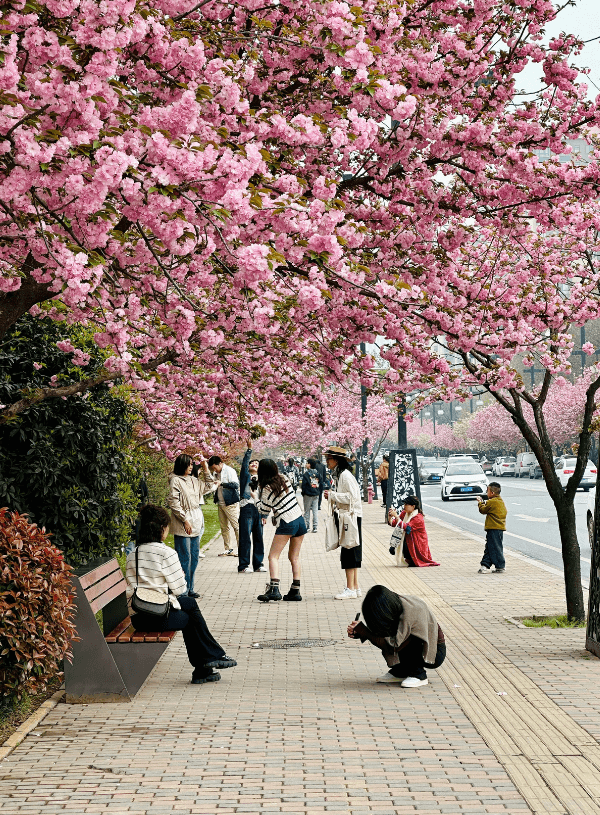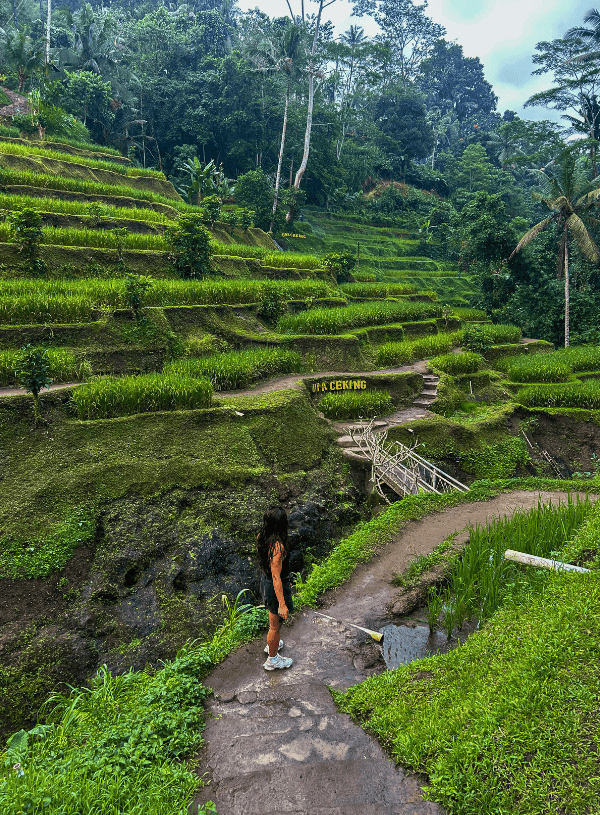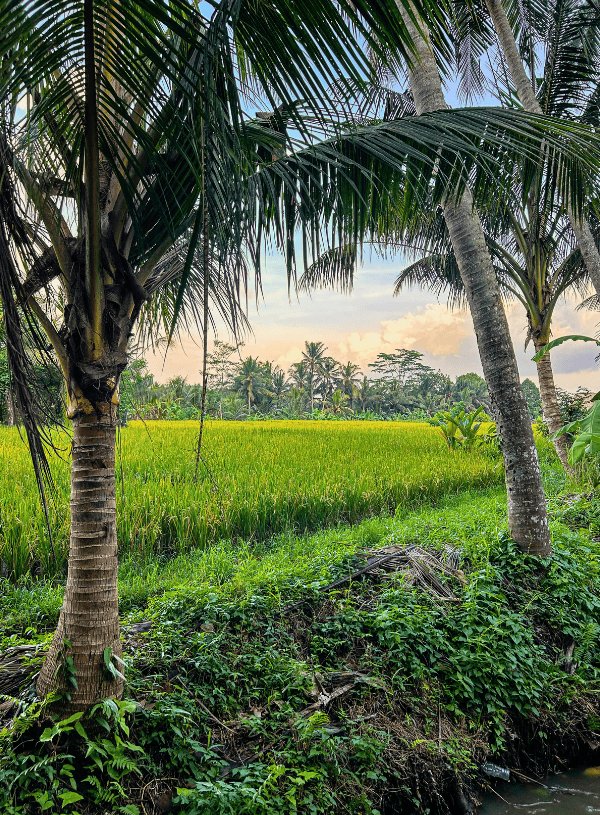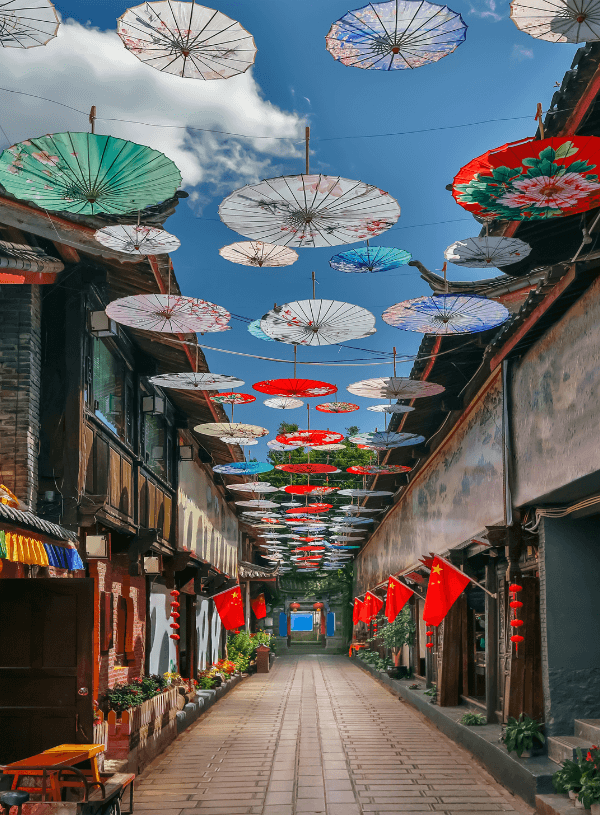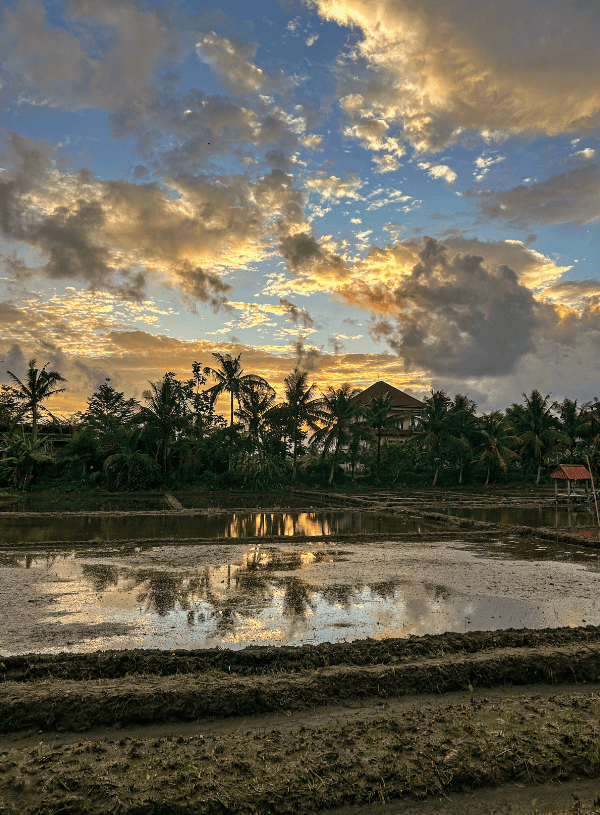32 Best Things to Do in Ubud: Touristy & Non-Touristy Things to Do & See (In Town & Around)
Last Updated on October 12, 2025
Are you planning your trip to Ubud? You’re in for a treat.
I first visited Ubud at the end of 2024… and completely fell in love with this place. To the point that I packed up my life and moved here in June 2025.
Ubud is one of the most visited spots in Bali – and yes, it’s busy, it’s touristy, and there’s definitely traffic… but only if you stick to the classic tourist areas.
What many people don’t realize is that Ubud still holds hidden corners that will make you stop and wonder if this place is even real. From secluded river temples to unknown rice fields and peaceful little streets, Ubud is full of magic — you just need to explore it the right way.
In this post, I’ll share the absolute best things to do in Ubud (and around). Of course, you’ll find the must-see tourist spots, but also hidden gems only locals or long-term visitors know about, and my personal favourite activities that I keep going back to while living here.
This article may contain affiliate links. This means that if you purchase through one of the links, I may be paid a small commission at no extra cost to you. Thank you for supporting the blog and allowing me to keep sharing meaningful travel experiences with you.
Don’t have time now?📌 Save it for later!
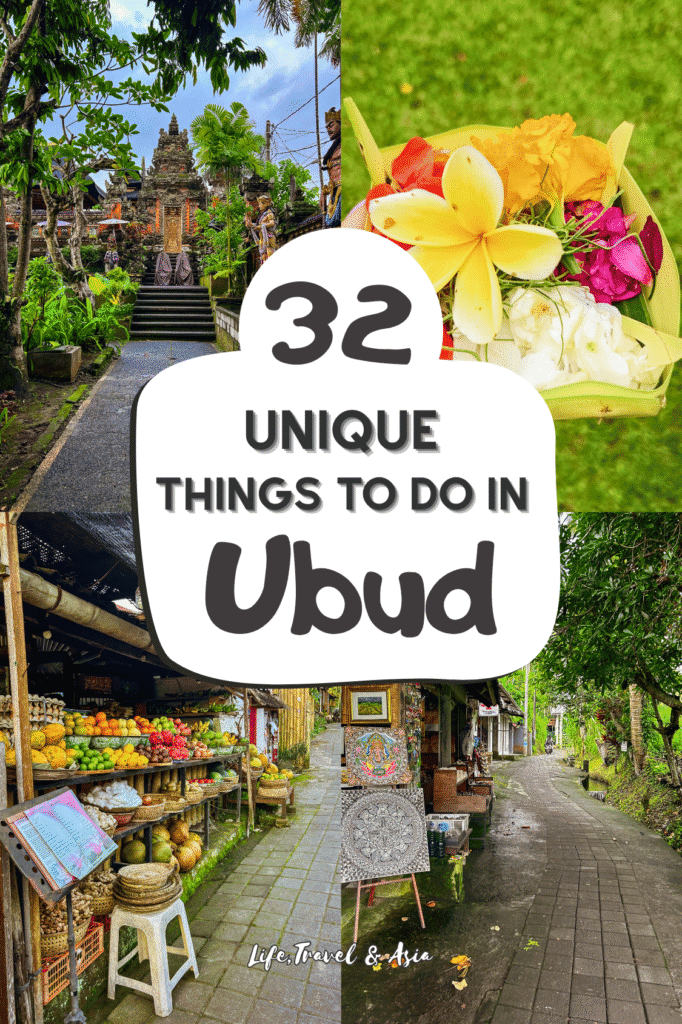
Don’t Have Time? Here Are My Favorite Experiences in Ubud
Must-See in Ubud: Tourist Spots
In central Ubud, right along the town’s busiest street — Jalan Raya Ubud — you’ll find what I like to call the “Ubud classics.” These are the iconic spots you can’t miss if it’s your first time here, and they pop up on pretty much every Ubud itinerary.
Here’s the rule when visiting them: go early. And I mean at opening time. It’s the only way to enjoy these places without having to squeeze through the crowds or fight for that perfect photo spot.
1. Puri Saren Agung: Ubud’s Royal Palace
Ubud Royal Palace is right in the heart of town, along the busy main road, surrounded by the constant hum of traffic and the voices of tourists passing by. Yet, the moment you step inside, it feels like the chaos is miles away. It’s surprisingly quiet — you can barely hear a thing from the outside.
The palace opens around 7:45 to 8 AM (not at 7), and that’s honestly the best time to visit if you want to enjoy it without the crowds or tour groups. You’ll have the chance to admire the beautiful Balinese architecture, golden shrines, towering red-sandstone gates, and the lush green garden in peace.
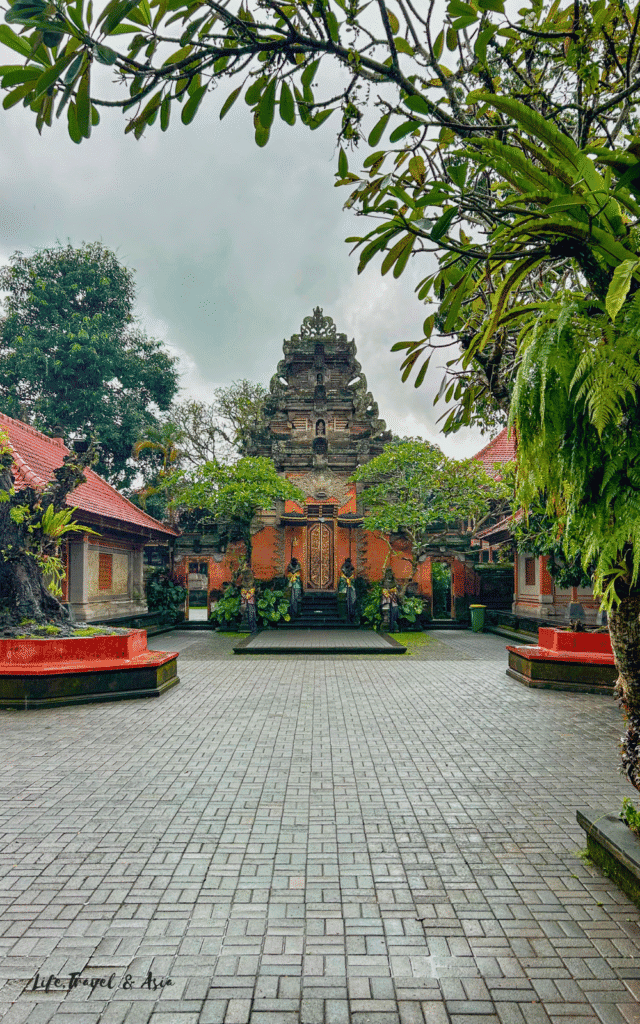
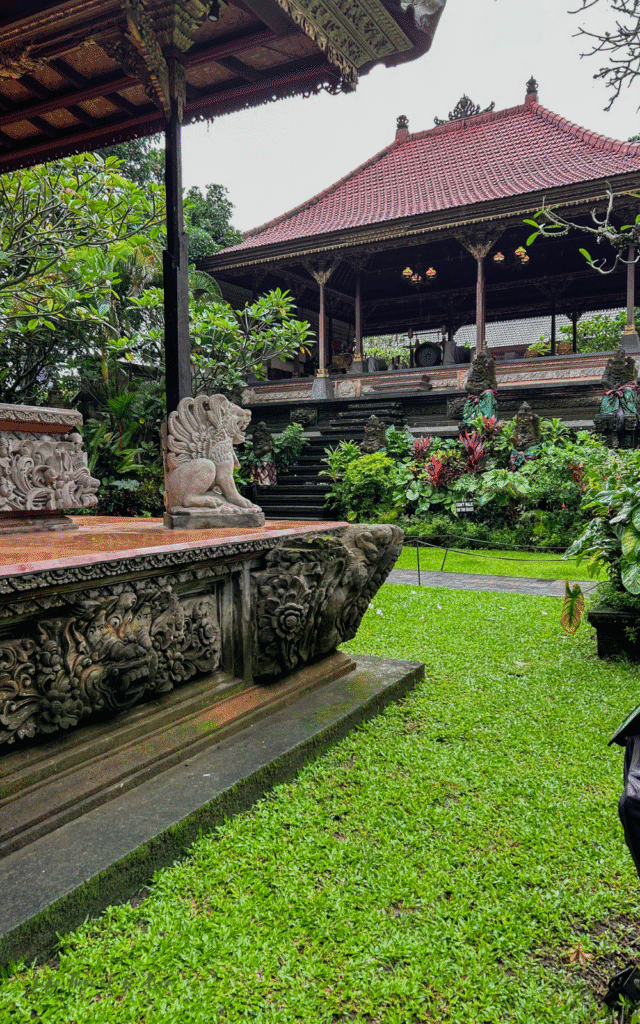
Although much of the palace was rebuilt after the 1917 earthquake, the royal family still resides there, so not all areas are open to the public. But if you’re curious to see a more exclusive side of the palace, there are a few Airbnb rooms hosted by the residence that give you access to some private sections and even the inner courtyard.
The site itself isn’t huge. There are two separate enclosed areas you can explore, and unless you join a guided tour to dive deeper into the history, you won’t need more than 15 to 20 minutes to walk around — maybe a little longer if you stop to take photos (which you probably will).
2. Pura Taman Saraswati: Saraswati Temple
The Saraswati Temple is a beautiful worship site dedicated to the Goddess Saraswati, located in the heart of Ubud, just a short walk from the Ubud Palace. As a visitor, you can only explore the garden — the temple itself is closed to the public.
That being said, the garden is honestly one of the prettiest you’ll come across in Ubud, and it feels so different from the typical traditional Hindu temples. The famous lotus pond creates the dreamiest scenery.
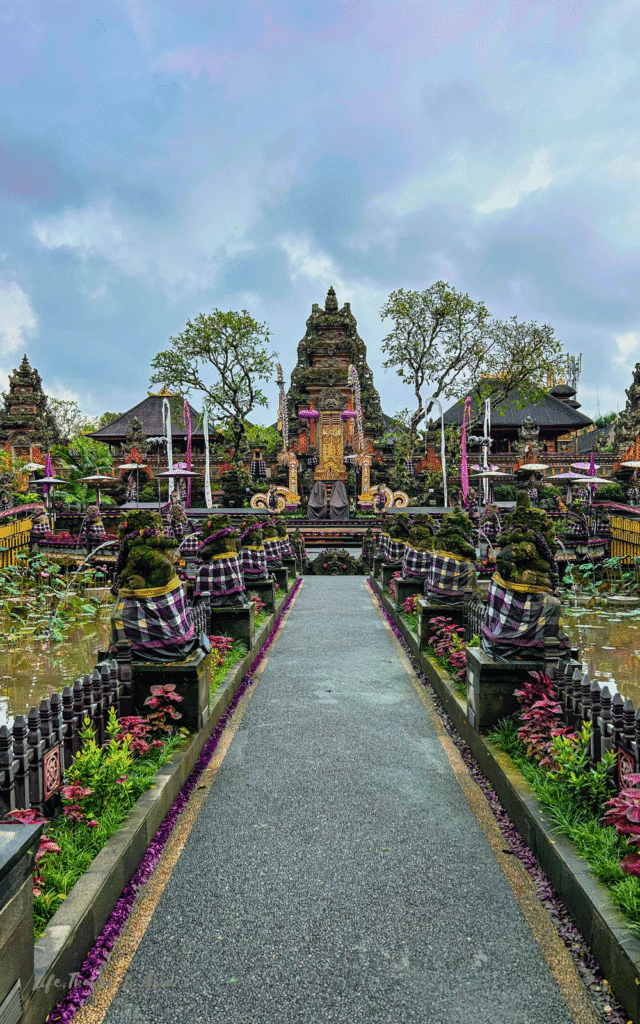
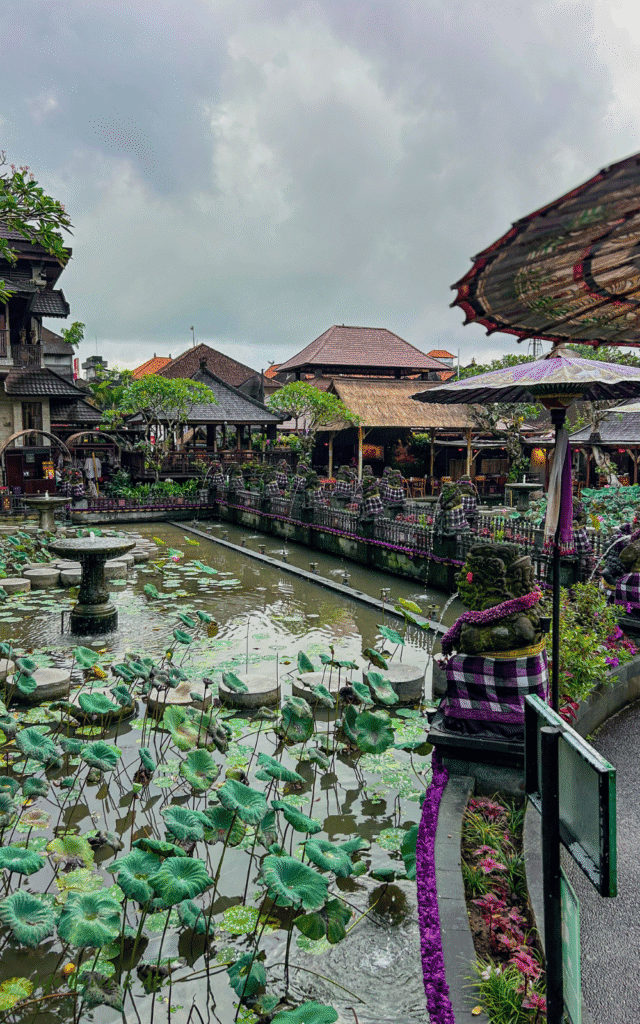
The garden is small, but every little corner deserves your attention — from the bridge crossing the lotus pond, to the detailed statues decorating it, to the red sandstone gates standing at the corners of the garden.
The ticket price is, in my opinion, a little high for what you get, considering you can’t enter the temple itself, and the garden is relatively small (60k IDR). But still, if you love photography or want to see the iconic lotus pond, it’s worth a quick visit.
30 minutes is more than enough to explore the garden and take your pictures — you really won’t need much longer. As for the dress code, they’ll provide you with a sarong and vest, which are mandatory to enter.
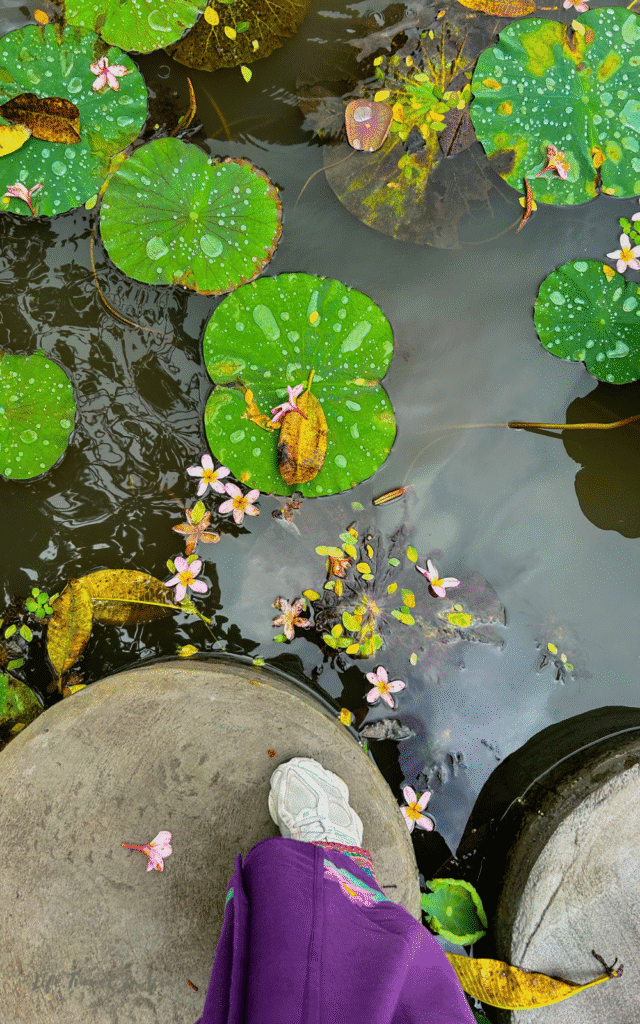
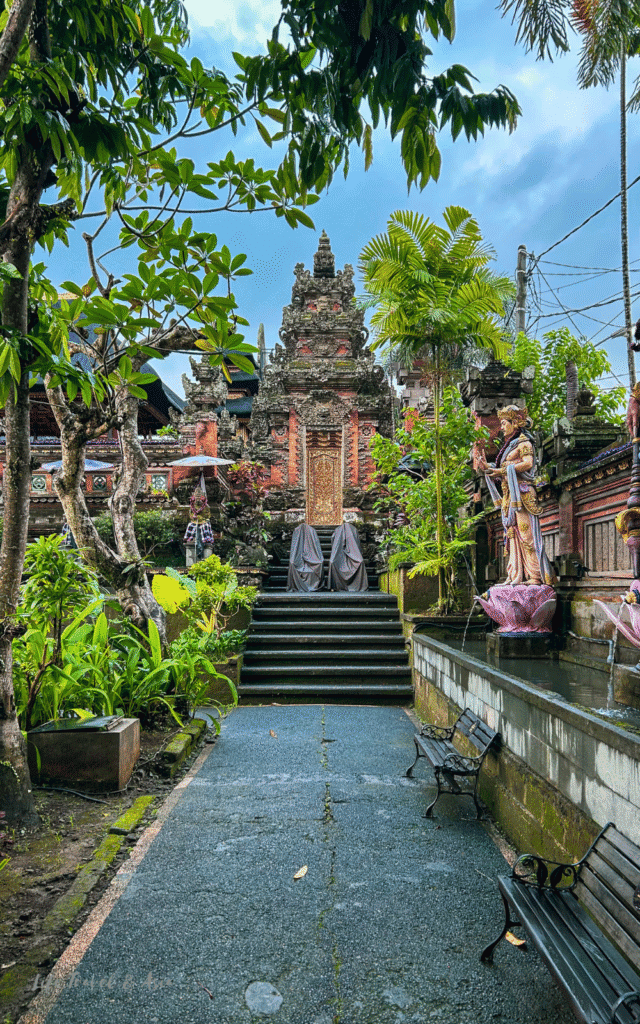
For the best experience, I highly recommend arriving right after opening time, around 8:00 AM. When I visited at that time, there was no one else around, which made up for the fact that the garden itself is pretty small. (I passed by on the same day at 12, and there was a queue).
I could hear the calming sound of the water flowing and the peaceful music playing softly in the background — it created such a quiet, magical atmosphere that I wasn’t expecting right in the heart of Ubud.
3. Sacred Monkey Forest
If you can look past the theme-park vibe at the entrance, visiting the Monkey Forest can actually be a really fun way to spend a couple of hours in Ubud. Let’s be honest… monkeys are hilarious. At least when they’re not trying to steal your belongings!
I enjoyed my visit for two main reasons. First, the forest itself. Even just walking along Jalang Monkey Forest, you’ll notice those massive trees with their twisting branches hanging down, completely blocking the sky. (And if you don’t have time to go inside, strolling along that road is a great way to spot some monkeys playing around.)
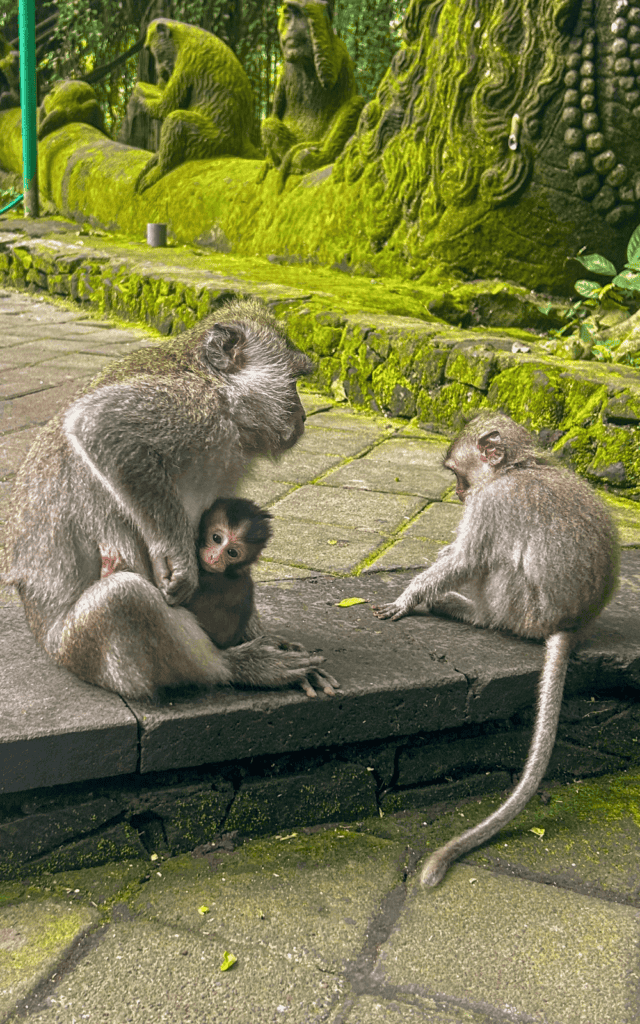
The second reason? Of course… the monkeys themselves. You could easily spend hours watching their movements and little interactions. Just keep in mind: don’t make direct eye contact or flash a big smile at them… they might see it as a challenge.
If you decide to explore deeper into the forest, you’ll eventually reach three temples hidden inside the grounds: Pura Dalem Agung Padangtegal, Pura Beji Padantegal, and Pura Prajapati Padantegal.
The temples are only open for prayer and local ceremonies, but you can admire their structure from the outside. Honestly, wandering through hidden temples tucked away in the jungle is one of my favourite things to do in Ubud — and the atmosphere here is truly special, especially if you manage to find a quiet moment with no one else around.
4. Ubud Market
I’ll be honest — I personally don’t hang around the Ubud Market area much. It’s always way too busy for me, no matter the time of year. But if you’re visiting Ubud for your holidays and want to bring back some souvenirs, this is the place to look.
Be prepared for some serious bargaining — sellers here tend to raise prices, knowing that most people shopping in the area are tourists. Don’t be shy to negotiate!
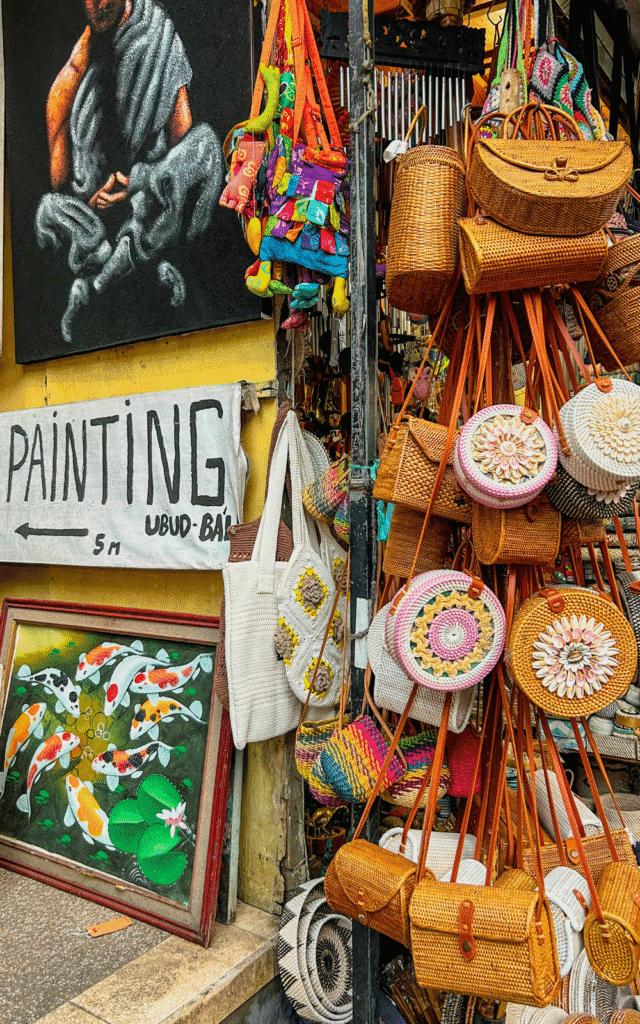
The market itself is a bit of a labyrinth. There’s a fresh produce section with fruits and vegetables, and a souvenir section packed with crochet Bali bags, magnets, sarongs, wooden carvings, incense holders, and every quirky Balinese find you can imagine.
You can start your exploration right in front of Ubud Palace, then head deeper into the busy alleyways — that’s where the absolute chaos begins.
5. Campuhan Ridge Walk: Ubud’s Most Popular Walking Trail
The Campuhan Ridge Walk is one of the most famous walking trails in Ubud, perfect for a peaceful morning walk or a light hike surrounded by nature. It was the very first place I explored on my first day here!
The best time to visit is early morning, ideally before 7 AM, when the air is cooler, the light is beautiful, and there are fewer people on the trail. Don’t expect to have it all to yourself, but it’s quieter than later in the day.

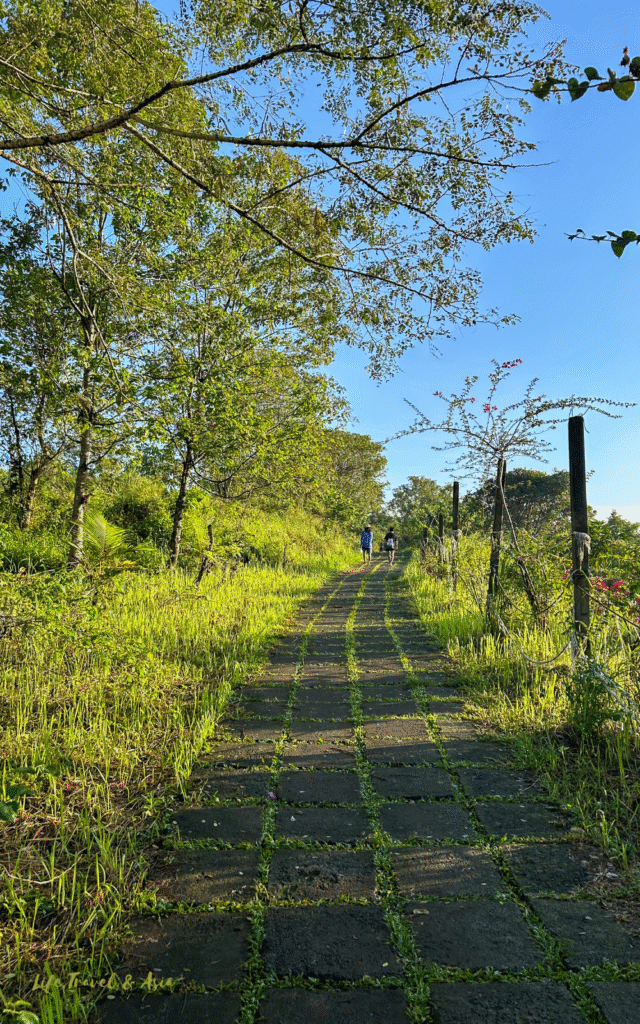
The highlight is right at the beginning: a peaceful path under the trees leads you to Campuhan Bridge and the beautiful Pura Gunung Lebah temple. From there, the trail continues through lush hills surrounded by jungle views on both sides — no warungs, shops, or tourist spots, just pure Ubud nature.
To get there, head to the western end of Jalan Raya Ubud. Follow the signs for Pura Gunung Lebah and turn at the entrance of Ibah Villas. The trail starts just past the temple. It takes about an hour, depending on your pace and how often you stop for photos.
Hidden Corners & Underrated Gems in Ubud
There are plenty of hidden corners in Ubud that you won’t find marked on any map. They’re the kind of places you only stumble upon if you have the time to wander without a plan. And I know that if you’re only in town for a couple of days, you probably don’t, and that’s why I’m here.
If you happen to be nearby, these places are always worth a stop. I can’t count how many times I’ve whispered to myself, “Wait… is this place even real?” That’s the kind of magic Ubud still holds.
6. Pura Dalem Ubud
Pura Dalem Ubud isn’t exactly a hidden gem; it’s right on the main road, just before the slope that leads toward the Penestanan area. But funny enough, it’s not on most tourist itineraries, probably because it’s rarely open.
Pura Dalem temples are traditionally temples of death, dedicated to Rangda, the demon queen, and often feature intense and slightly scary demon statues and carvings. The atmosphere, even from the outside, is powerful, a little eerie, and so fascinating.
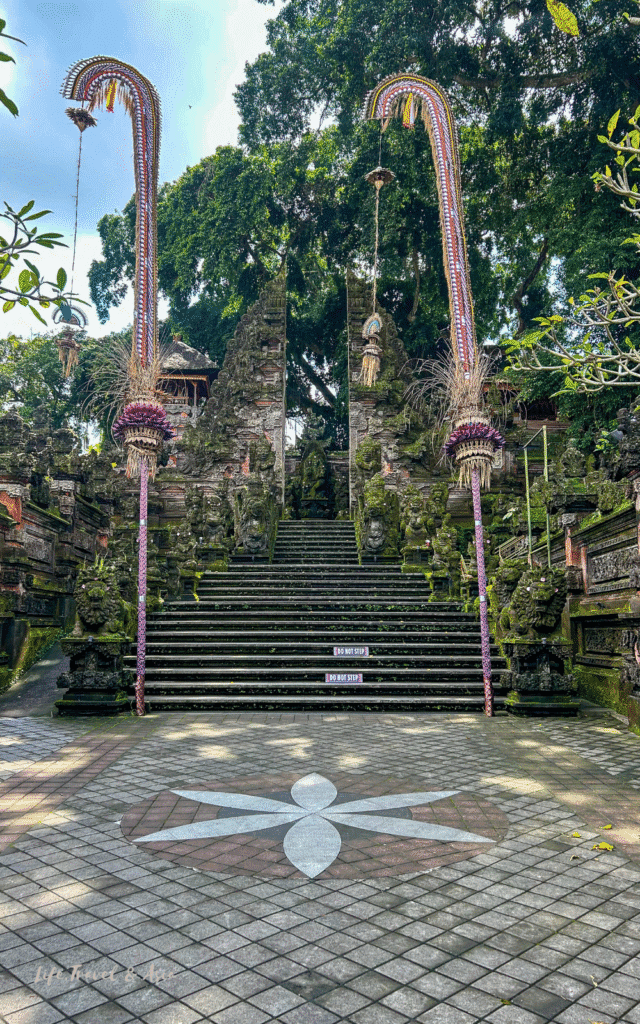
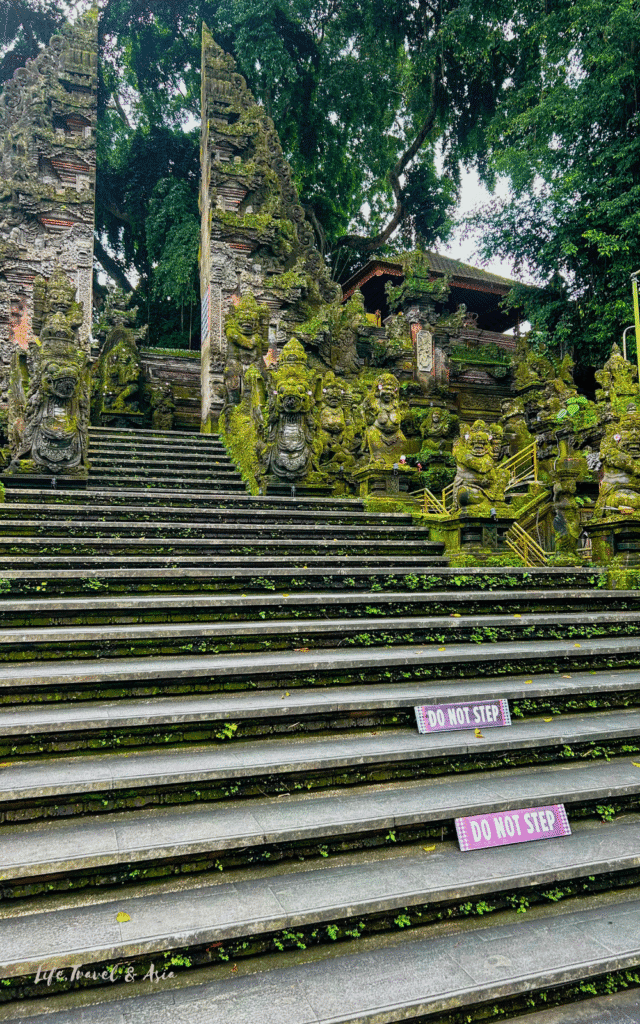
I’ve tried visiting a few times, but every time I go on purpose, it’s closed. Still, I always end up stopping to take pictures at that staircase and the dramatic candi bentar gate at the top. That view alone gives me chills and makes me want to sneak inside and explore every corner.
I have to admit… I even considered slipping in once when no one was around. I didn’t. But the temptation was real.
So far, I haven’t made it in — but I’ll keep trying to pass by with my sarong in my hands and hope for a lucky moment. If you want to be sure to see it, your best bet is to buy a ticket for the Kecak dance performance held there in the evening. That way, you’ll get to see the temple inside and a cultural show all in one.
7. Pura Gunung Lebah & View from The Penestanan Bridge
Pura Gunung Lebah sits in what I think is one of the most fascinating corners of Ubud — right at the start of the Campuhan Ridge Walk, surrounded by the deep jungle.
Pura Gunung Lebah is one of the oldest temples in Bali. It was founded in the 8th century by an Indian priest who, feeling the mystical energy of the river valley, chose this exact spot to build a spiritual centre dedicated to meditation.
That probably explains why the whole area still feels so deeply magical. Even if you can’t get inside (it’s usually closed and only open during full moon ceremonies), it’s absolutely worth a stop.
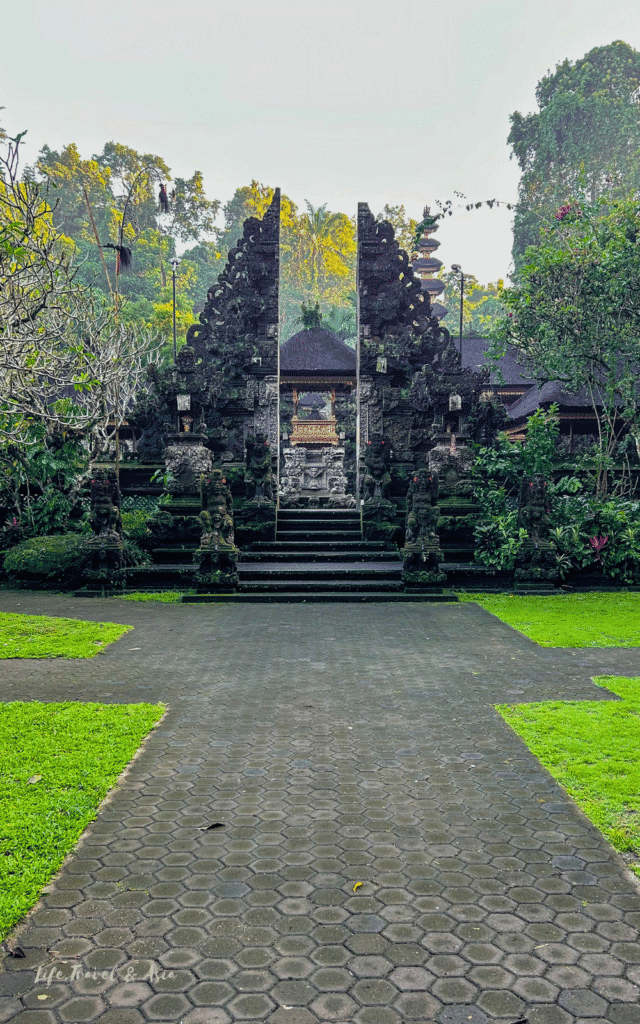
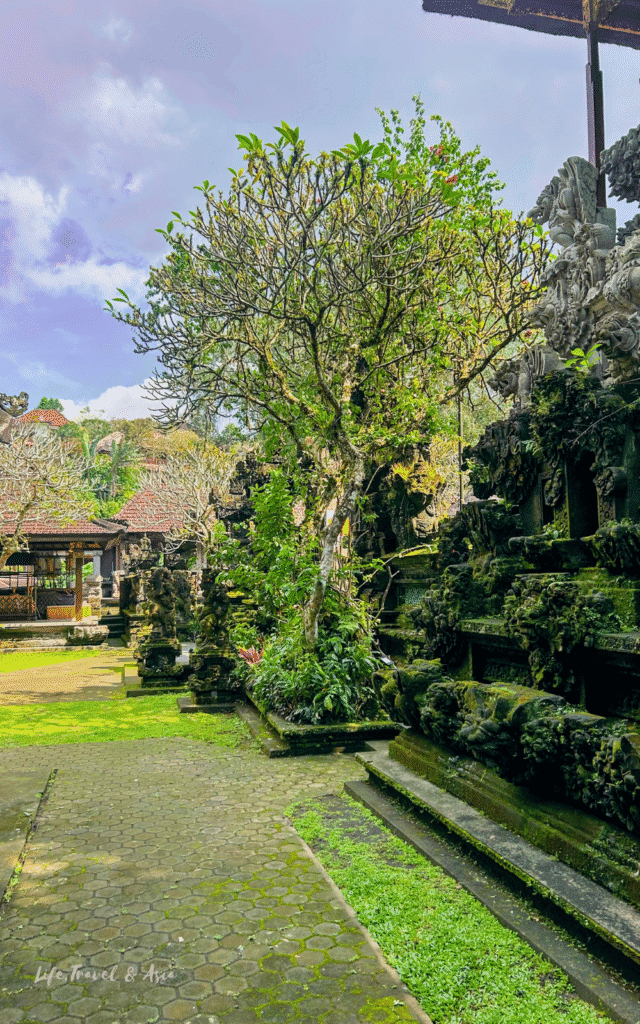
I highly recommend walking down to the entrance and peeking through the gates to get a close-up view of the inner courtyards.
And make sure to head towards the Penestanan bridge, the big one that overlooks the river. From there, you’ll get a view of the Merus surrounded by lush jungle — easily one of the most magical views in all of Ubud.
8. Beji River Sanctuary
The name of this small sanctuary on the Wos River is Beji, a water shrine where purification rituals are practiced, and is connected to Pura Gunung Lebah nearby.
This was actually the very first place that caught my attention — the thing that woke up my inner explorer the first time I came to Ubud.
The first time I stopped, it was getting dark, and something about it felt too mysterious. But on my second visit, I followed the stairs without hesitation.
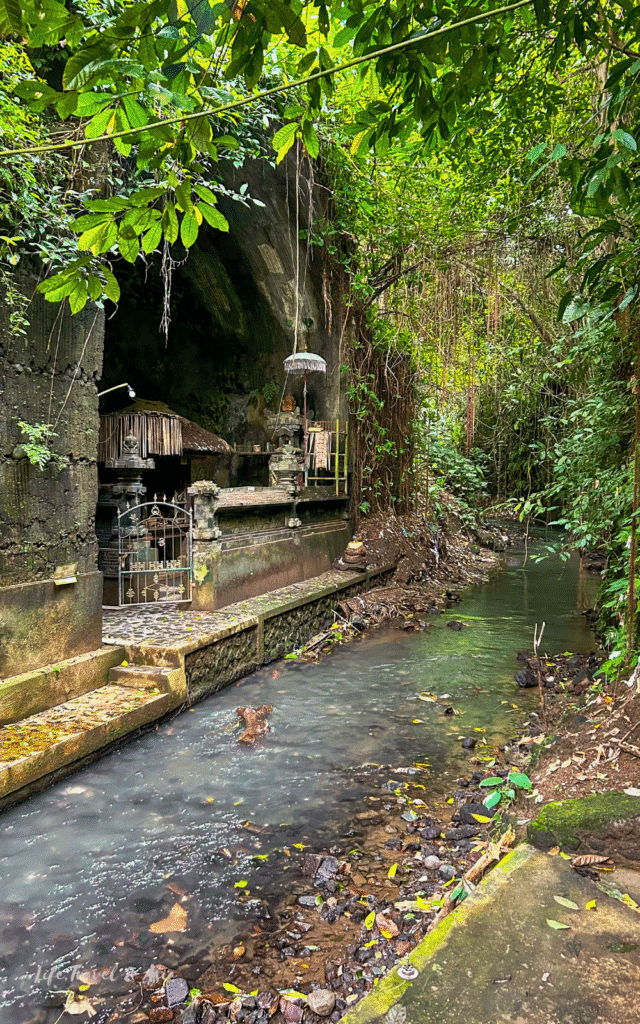
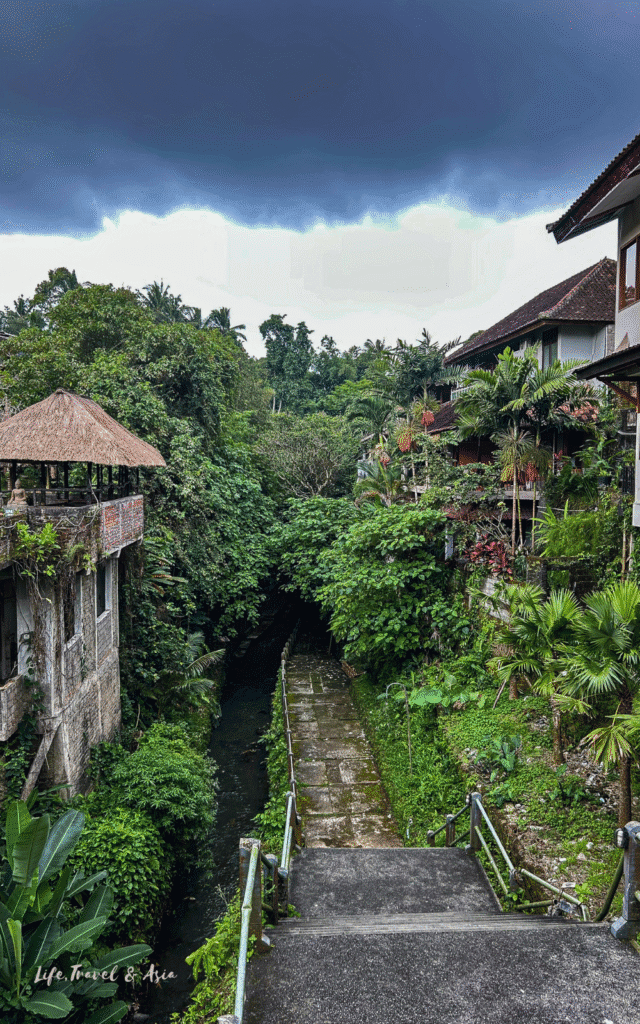
The path ends immediately, though not before revealing one of my favourite hidden corners in Ubud. The Beji sanctuary is nestled into the curve of a rock, just above the flowing river.
The space feels completely untouched, almost unreachable from the water below. It’s incredibly peaceful and full of spiritual energy.
There’s barely any information about this spot online. But if you want to find it, walk along Jalan Raya Ubud until you spot the Juwuk Manis Walk signage. Just after that, you’ll see a small stone area with a statue and a staircase going down toward the river.
9. Hidden Rice Field Walks
One of the reasons I chose Ubud as my first base in Bali is the endless possibilities for walking around surrounded by nature and rice terraces.
When people talk about Ubud, they often mention the crazy traffic along the main road, which is true; it is busy. However, you can also choose to explore the more authentic and peaceful areas, even if you’re only visiting for a few days.
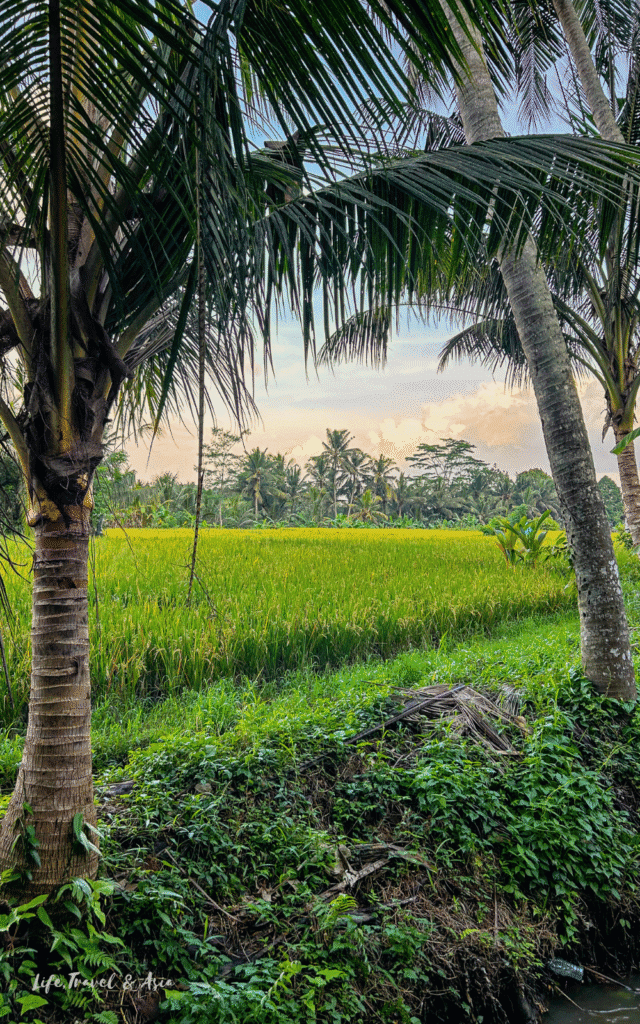

Rice field walks are such a beautiful way to experience the more local side of town, where you’ll meet smiling farmers, kids playing with their kites, and old ladies walking their dogs. Besides that, you’ll get to enjoy pure, quiet nature, surrounded by the most incredible views — and the best part? It’s completely free.
My favorite walk is the Penestanan walking trail. This isn’t one of the official walking paths — you won’t find cafés or restaurants like you might along other routes. It’s just pure nature and local farmers working in the fields. It’s a bit further out from the city center, but still easily reachable with a Grab bike.
If you’re looking to escape the crowds and enjoy a peaceful moment in nature, I’ve put together a guide to my favorite rice field walks in Ubud and how to get to each of them.
10. River Sanctuary in Penestanan
I don’t have much information about this small river sanctuary — I don’t even know its name. What I do know is that it feels like a place used by locals for water purification rituals, directly in the river. I’ve seen a man bathing there in solitude.
And honestly, this might be the most magical place I’ve seen in Ubud so far. It’s quiet, sacred, and entirely off the radar. I’ve never seen anyone else stop by, which honestly surprises me, because these are precisely the kind of places that drive me crazy (in the best possible way).
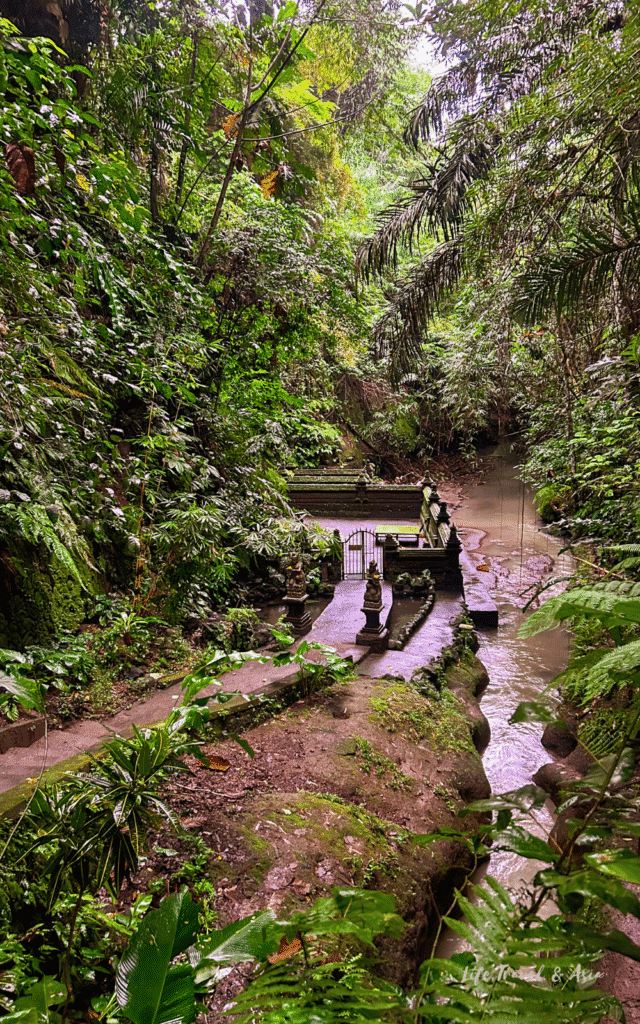
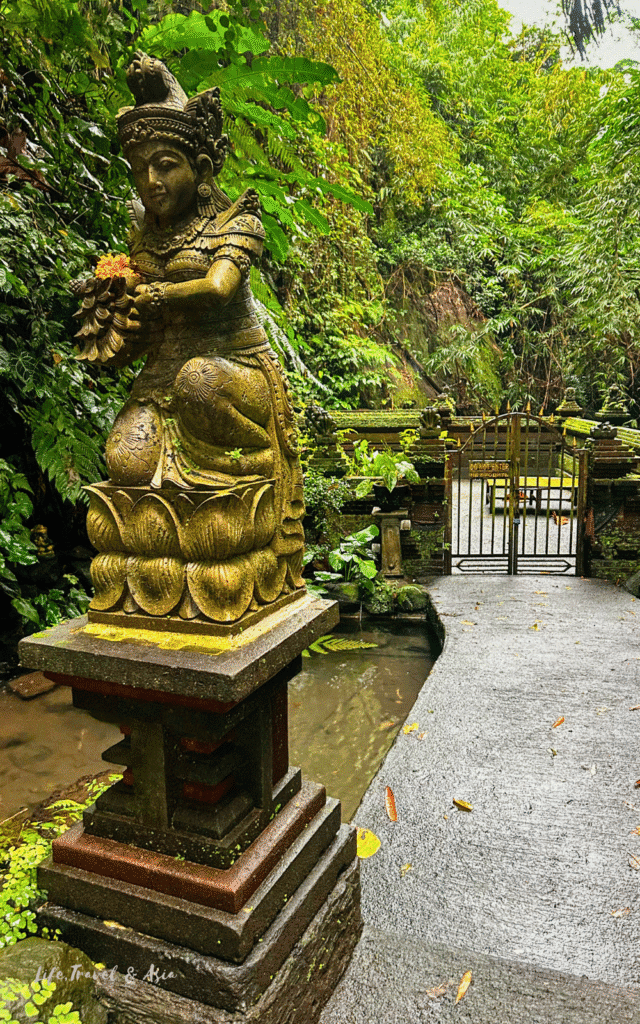
There’s no sign, no entry gate, and no real pin on the map. But if you want to find it, here’s how: search for Pugig Homestay in Gang Pacaken on Google Maps. Right before crossing the small bridge that overlooks the river, you’ll notice a big staircase on the right (or on the left, depending on where you arrive from) side leading down to the water.
I usually go there when I take my walk from Samkhia Villas to the Yellow Flower Cafe. From the road above, you can already spot the small, square-shaped stone shrine set right next to the river. You can’t enter, but you can quietly explore the outside and soak in the energy of the place.
If you’re anything like me, you’ll stand there in silence for a few minutes, wondering: How is this place even real? Is Ubud real?
Must-See Around Ubud: Typical Tourist Itinerary
11. Tegallalang Rice Terraces
Exploring the Tegallalang Rice Terraces was one of the first things I did after moving to Ubud. I had heard it all. Some say they’re a must-see, others call them overrated and touristy. So, I had to check them out for myself.
If you’re staying in Ubud and not planning to head further north to Central Bali, Tegallalang is a good chance to admire Bali’s iconic rice terraces without traveling far. I visited right at opening time, around 7 AM, and had the place (almost) to myself — just the sound of nature and the vivid green paddies covering the hills all around.
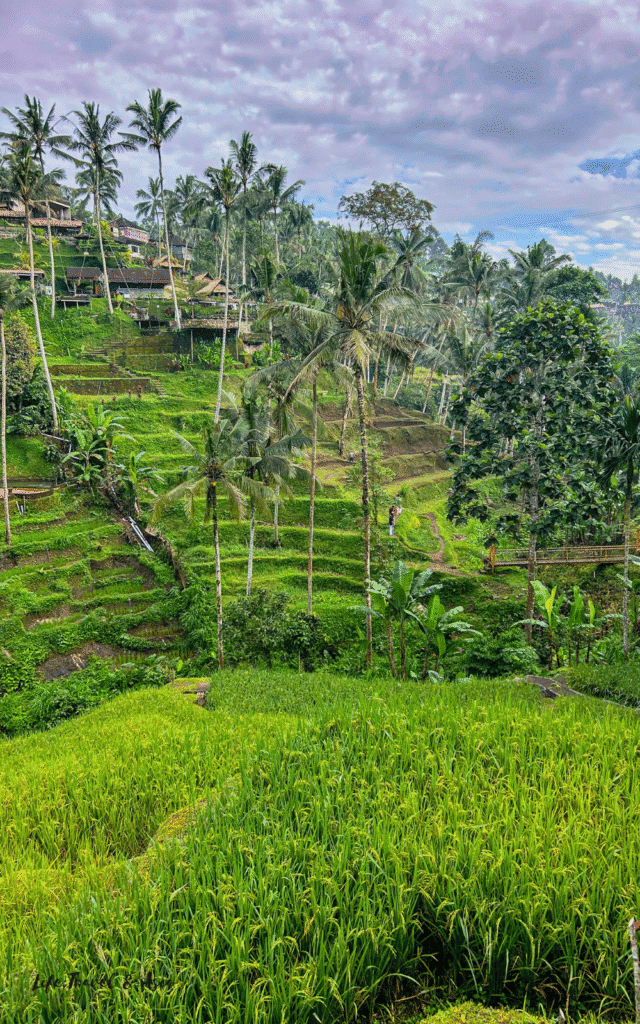

The site itself is unique. Unlike the vast, flat rice fields you’ll see in other parts of Bali, here the terraces cover the steep hillsides, meeting at a small river at the bottom. It’s undeniably pretty — but be ready for steep stairs, humidity, and a bit of a workout if you want to explore beyond the main viewpoints!
Before planning your visit, be sure to read my honest review of the Tegallalang Rice Terraces. I share everything you need to know to decide if they’re truly worth your time and how to enjoy them at their best.
12. Kanto Lampo & Tegenungan Waterfall
If you’re short on time and want to visit a waterfall close to Ubud, then Kanto Lampo and Tegenungan are your best bet. However, be aware that to fully enjoy them, it’s best to go very early in the morning.
If you have to choose one, Kanto Lampo is the prettiest of the two, and that’s also why it’s considered the Instagram-worthy Bali waterfall by definition.
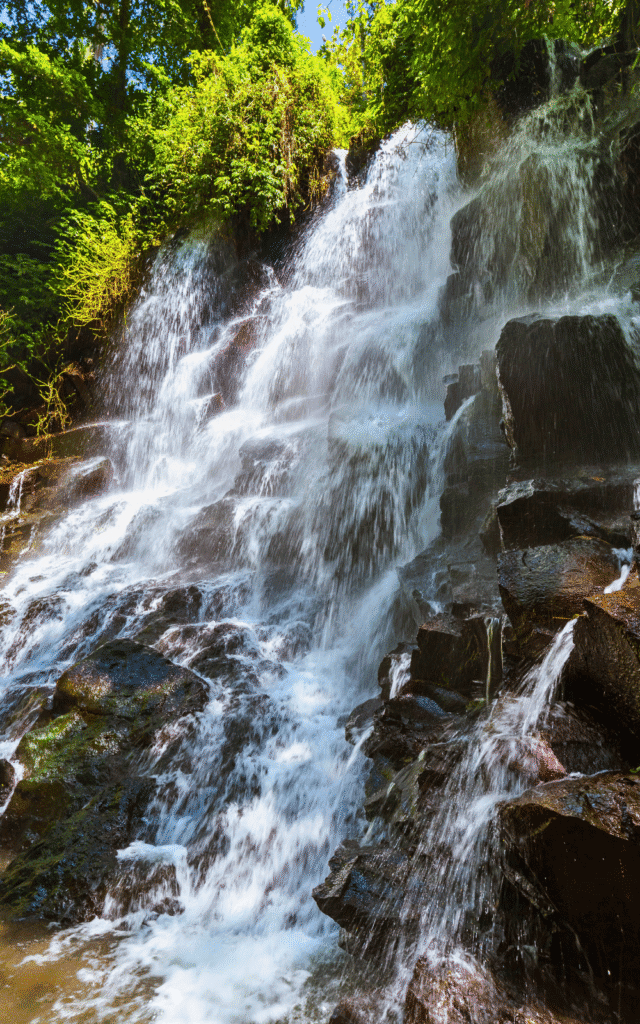
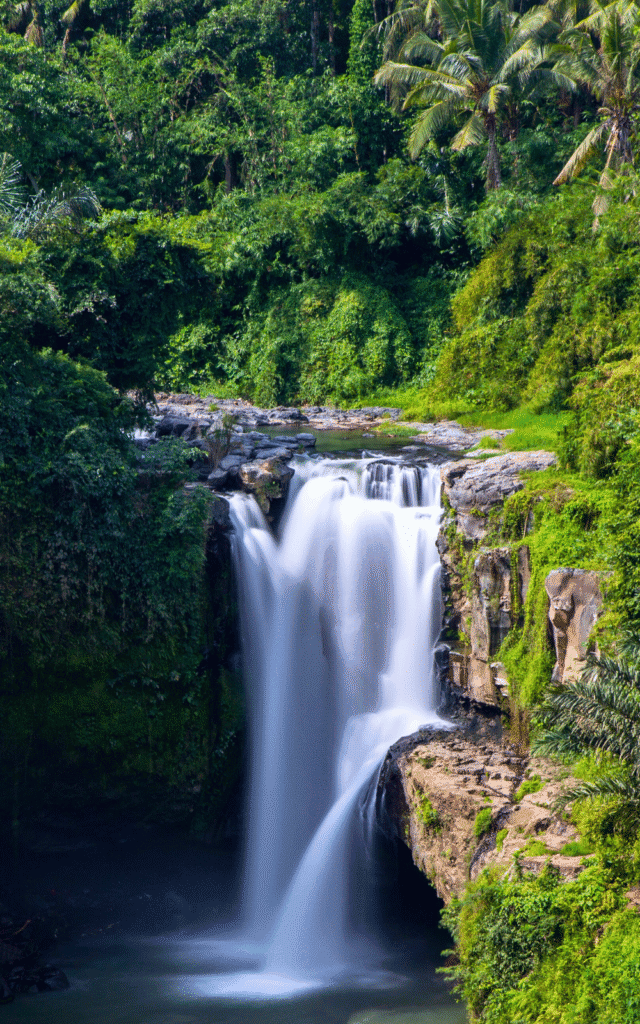
Kanto Lampo is a stunning tiered waterfall that flows over rocks, making for fantastic photos right in the middle of it. It’s located about 30 minutes from Ubud. This one can easily be paired with other nearby waterfalls, making it the perfect little day trip from town.
You can find everything about my morning chasing waterfalls east of Ubud in this blog post.
Tegenungan, on the other hand, is a 15-meter single-drop waterfall that flows into a natural pool where swimming is possible. It’s more or less the same distance, just slightly south of Ubud.
13. Mount Batur
One of the most popular day trips from Ubud is the Mount Batur Sunrise Hike. Mount Batur is an active volcano located in the Kintamani region, around an hour and a half from Ubud.
Mount Batur is 1,717 m above sea level and the second-highest peak in Bali after the volcano Gunung Agung at over 3,000 m.
Many tours leave from Ubud, with the trek usually beginning around 3 am to ensure you reach the summit in time for sunrise. Once at the top, you’ll be rewarded with a view you won’t soon forget.
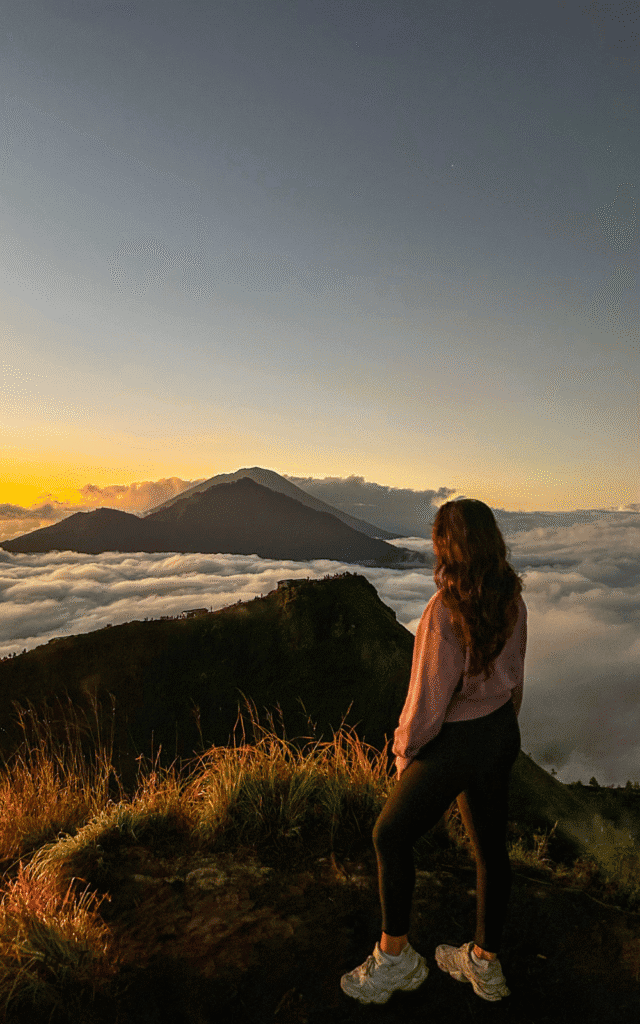
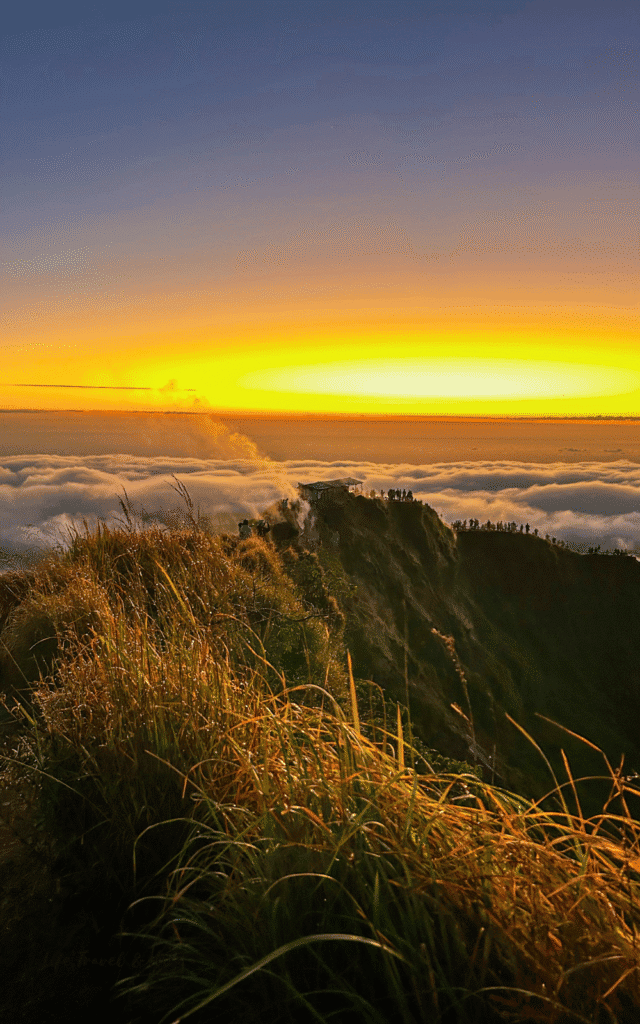
Once you reach the top, you’ll get to explore the caldera, watch the sunrise (if the weather is on your side), and see a sea of clouds covering Kintamani. On a clear day, you can even spot Gunung Agung rising on the other side of the lake.
I recommend booking a tour for the hike. The second part is super rocky, and there aren’t any marked trails—only the local guides know the way up. Honestly, I wouldn’t have made it without one.
If you’re looking for a good option, check out this sunrise tour from Ubud with Seek Sophie. It’s guided by locals from Kintamani who’ve been hiking this volcano their whole life. They know all the quiet paths, the local stories, and the best photo spots. Plus, it’s a group tour, so transportation is included, and it ends up being way more affordable than most.
If you’re wondering what it’s like hiking an active volcano, I’ve put together a guide to the Mt. Batur sunrise hike: what to expect, how to plan, what to pack, and the best tours you can choose to make sure you’ll have the smoothest experience.
14. Pura Tirta Empul
Pura Tirta Empul is one of Bali’s most sacred water temples, renowned for its mystical waters.
These holy springs, believed to have been created by the God Indra, are said to contain blessed water that purifies those who participate in the Melukat ritual. This famous purification ceremony is the main attraction for most visitors to this site.

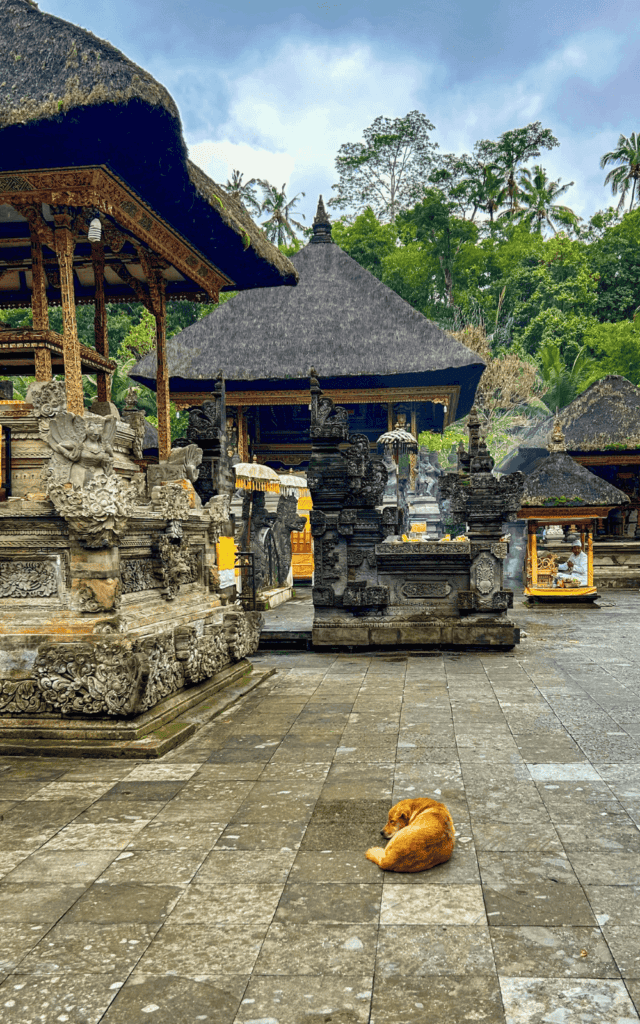
Here you can plan your Melukat Ritual (even if it may not be the calming and spiritual experience you’re expecting). You can also explore the temple grounds, which are often overlooked by those who come solely for the water purification ritual.
Pura Tirta Empul is a genuine masterpiece of Balinese temple architecture, and even if you don’t participate in the ritual, it’s truly worth a visit. Especially, the Jeroan, which is the area right past the bathing pools.
This is the temple’s most sacred courtyard, dedicated to prayers. Here, you’ll witness Balinese Hindus in worship and practice and feel the spiritual energy that makes this place truly special.
If you’re in Ubud and considering a visit to this site, I’ve put together a detailed blog post with everything you need to know about Pura Tirta Empul: from what to expect to how to plan your visit and discover the atmosphere of the site.
15. Goa Gajah (Elephant Cave)
Goa Gajah, or Ubud Elephant Cave, is worth a stop if you’re in Ubud. Just a quick 15-minute drive to Bedulu, this ancient Hindu sanctuary has a mystic and spiritual atmosphere, with its origins still somewhat unknown.
Discovered by Dutch archaeologists in 1923, it was likely a sanctuary for Hindu priests who probably built and carved the demon at the cave’s entrance around the 11th century. However, the nearby Buddhist temple area suggests that early Buddhists in Bali also found peace and a place to meditate here.
There must have been something special in the air attracting spiritual practitioners to this place.
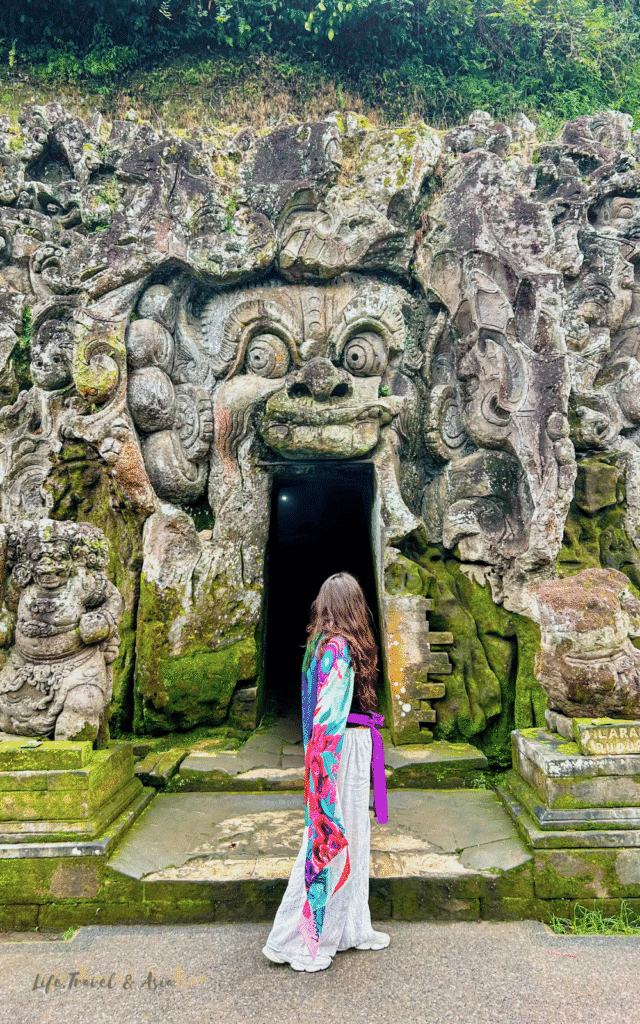
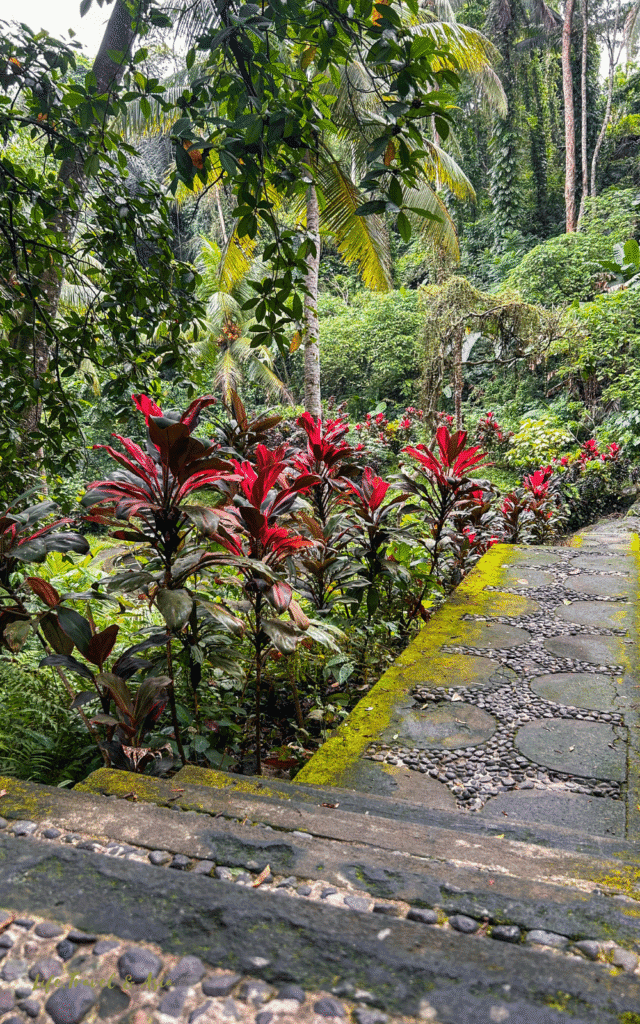
The cave’s name likely comes from the nearby Petanu River, which translates to Elephant River. You’ll enter through the mouth of a demon and walk down a narrow corridor that opens into two rooms.
One room features a statue of the Hindu god Ganesh, while the other showcases the phallic symbols of Shiva and her female counterpart, symbolizing the cycle of life.
Don’t stop at the grottoes—there’s more to explore! Beyond the bathing pools, you’ll find some trails in the jungle you won’t want to miss. Climb a stone staircase to discover tropical gardens, and continue along the path to a hidden canyon by the river and a temple tucked away in the jungle.
If you’re around Ubud and thinking of visiting this site, I’ve put together a detailed blog post with everything you need to know about visiting Goa Gajah: from what to expect to how to plan your visit and what not to miss on site.
Off-The-Beaten Path Around Ubud
16. Gunung Kawi Sebatu Temple
Gunung Kawi Sebatu is one of those temples most visitors have never heard of — and yet, when I asked one of my guides for a recommendation near Tirta Empul, this was the very first place he mentioned. So, of course, I had to go. And honestly? It turned out to be one of the most beautiful temples I’ve seen in all of Bali.
It’s not a large temple, but the beauty and sacred energy of the place hit me even before I stepped inside.
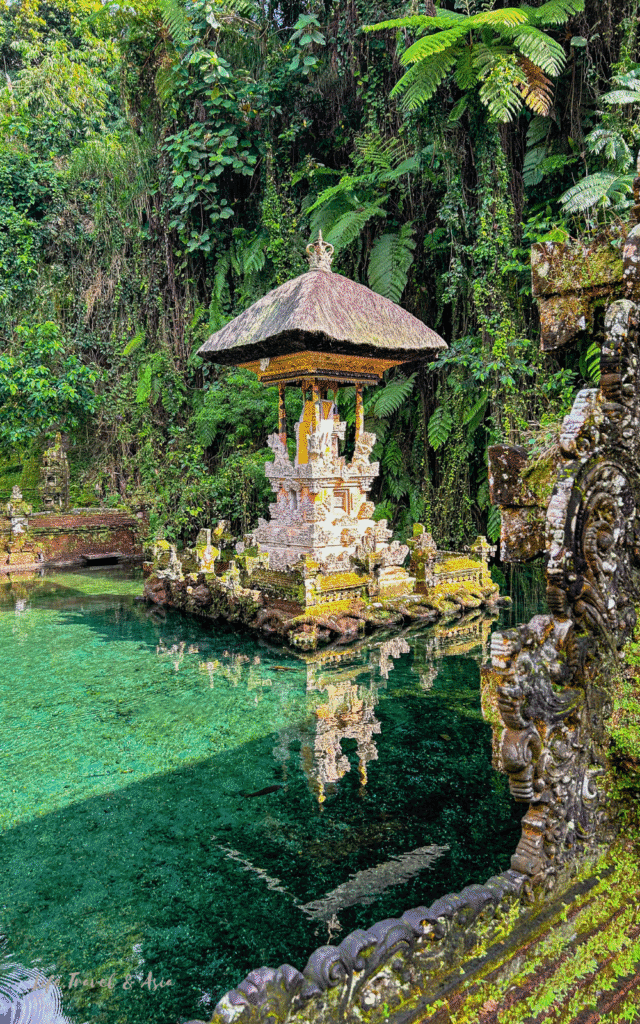

What stayed with me was the atmosphere: the blend of silence, natural beauty, and spirituality. When I arrived, the temple was quiet — just a few young Balinese women making offerings and lighting incense in front of the altars.
The temple follows the traditional Balinese Hindu layout, with three courtyards representing the three realms of existence: the outer world, the middle world, and the most sacred inner sanctuary.
To the left, you’ll find a garden overflowing with tropical plants and colorful flowers, overlooking clear spring-fed pools where the Melukat purification ritual is often performed. To the right and in front of you are the sacred shrines typical of Balinese temples.
If you’re planning to explore some temples around Ubud and want to visit this hidden gem, I’ve written a dedicated post all about Gunung Kawi Sebatu, including how to plan your visit, what to see nearby, and of course, lots of beautiful photos.
17. Gunung Kawi Tampaksiring Temple
Not far from Gunung Kawi Sebatu — and with a similar name but a completely different vibe — lies Gunung Kawi Temple, a truly mystical site hidden in the jungle of Tampaksiring.
Gunung Kawi is a funerary complex, dedicated to Balinese and Javanese royalty. It also includes Pura Gunung Kawi, a temple area with courtyards and shrines, though to be honest, that part isn’t really the highlight.

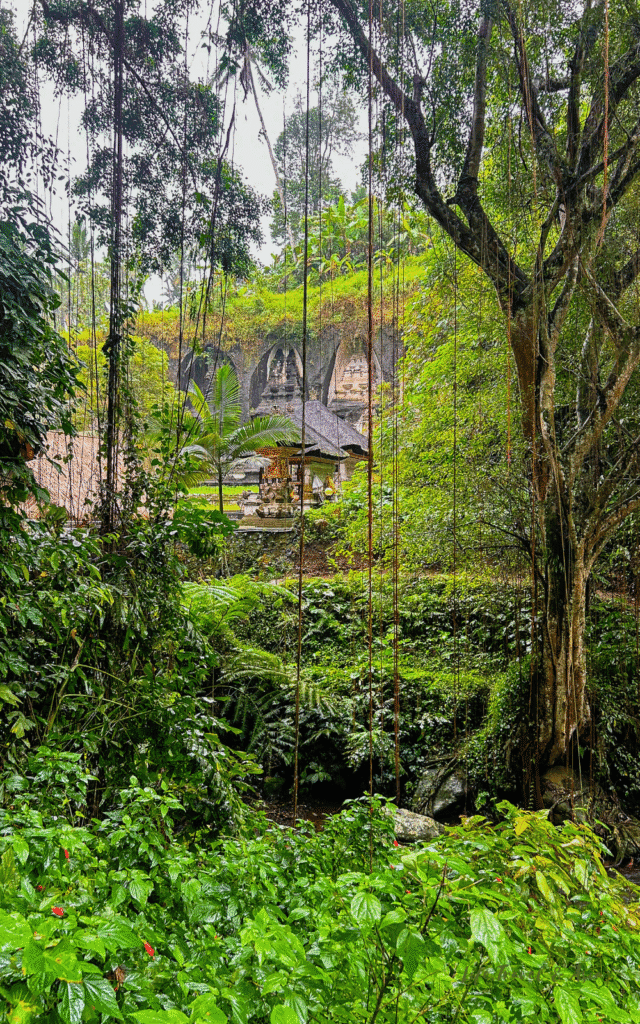
What makes this place unforgettable are the massive shrines carved directly into the cliff walls, known as candis in Balinese. There are ten of them in total: four before reaching the main temple, five after passing it, and one hidden. These towering stone structures are unlike anything else I’ve seen in Bali.
The other element that makes Gunung Kawi so special is the setting. The entire complex is surrounded by the jungle, with giant banyan trees whose branches touch the ground and completely block the view across the valley. It feels ancient and also a bit gloomy.
If you’re looking for a temple that stands out not only for its spiritual significance but also for its architecture, Gunung Kawi is a great choice. Just make sure to go in the morning, when there’s no one around.
If you’re planning to add this mystical temple to your Ubud itinerary, I’ve written a dedicated post all about Gunung Kawi, including how to plan your visit, what to see nearby, and of course, lots of beautiful photos.
18. Pura Mengening
Pura Mengening shares a similar energy with Gunung Kawi Sebatu — it’s a small water temple with a deeply spiritual atmosphere, not so popular, and its holy pools are used for the traditional Melukat purification ritual.
What makes Pura Mengening unique is its layout: the temple is divided into two parts. The first area seems to have risen directly from the earth, carved into the valley. Here are koi ponds and spring-fed purification pools, set along a stairway that leads you downstream toward the lower altar.

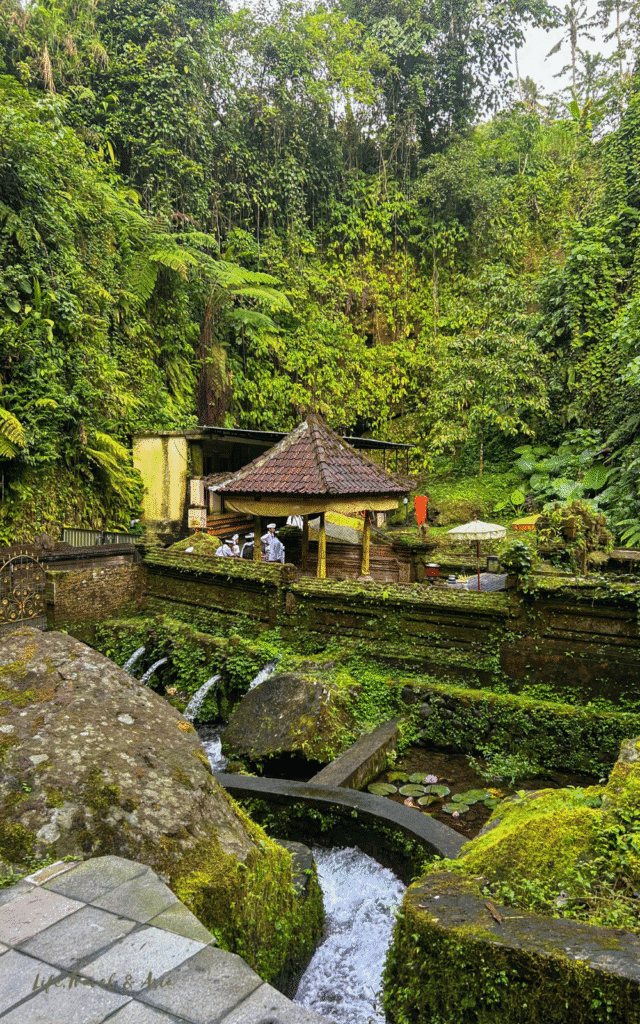
The second part — the main temple structure — is perched on top of a hill and, unfortunately, inaccessible to visitors. You can, however, climb the stairs that lead up beside it to have a look inside the temple grounds and enjoy a 360° view over the temple grounds and surrounding jungle.
Interestingly, the same sacred water stream that flows through Tirta Empul also runs through Pura Mengening. But here, the vibe is entirely different. When I visited around 8 AM for a purification ritual, it was just me, my guide, and the temple keepers.
If you’re looking for a sacred place to perform a Melukat ceremony away from the chaos of more famous temples, Pura Mengening is a beautiful choice.
19. Mancigan Rice Terraces
I had no idea these rice terraces even existed until I visited Gunung Kawi Temple. The Mancigan rice terraces stretch across the Tampaksiring valley, not far from the temple, and are absolutely stunning — yet unknown to most tourists.
As soon as we arrived at Gunung Kawi, I couldn’t help but stop and ask my driver about it. He explained that these terraces are still actively used by local farmers and aren’t set up for tourism. You can tell, because there aren’t even ticket booths.
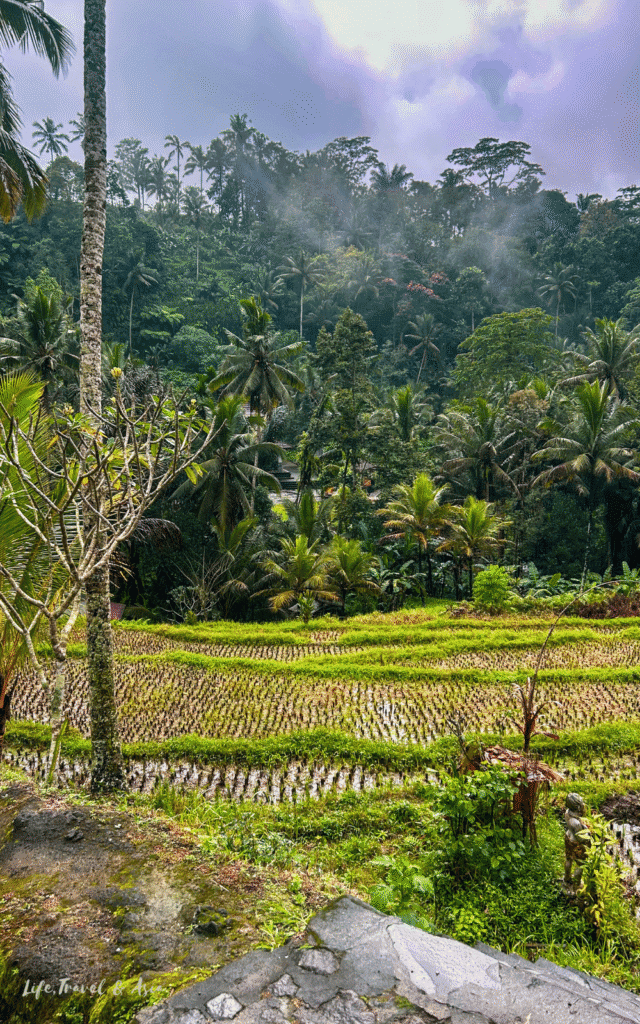
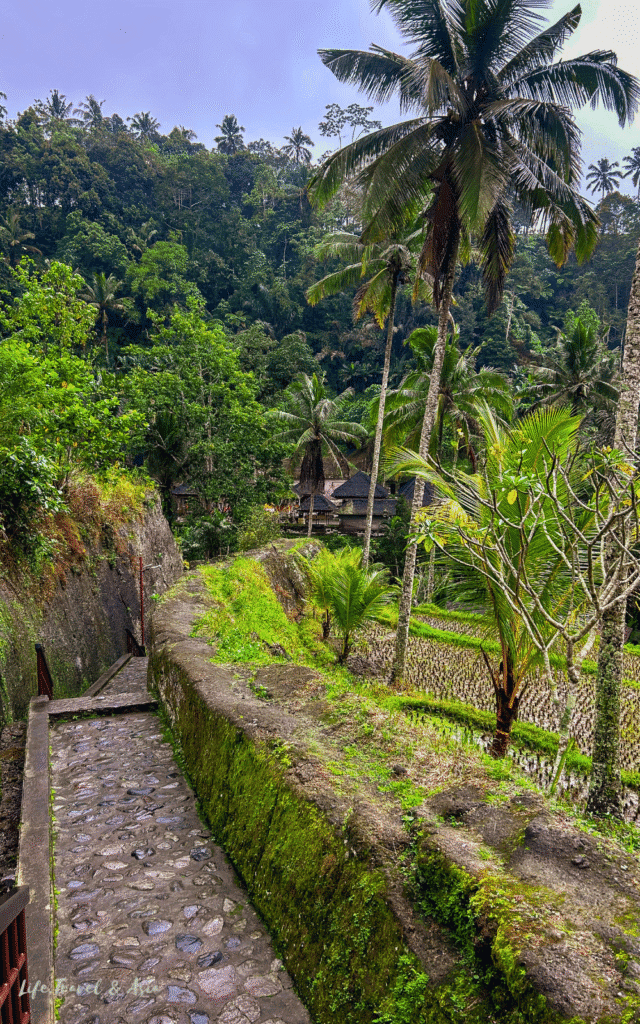
If you’re looking for a peaceful and authentic rice field trekking experience, this is such an underrated spot. You’ll likely see farmers at work and kids playing on the edge of the paddies.
It’s also easy to combine a walk here with a visit to the nearby temples and enjoy a simple, affordable lunch at a local warung.
If you’re looking to see more of Bali without changing base, these are my favorite day trips from Ubud. They’re very simple to plan and will make your itinerary much more interesting.
Best Activities in Ubud
20. Book Relaxing Spa Treatments at Ubud Sari
Located at the end of a busy market street in central Ubud, Ubud Sari Health Resort is a wellness retreat center immersed in nature. It’s not flashy or over-designed — and that’s precisely what makes it special.
I visited for a massage and a facial, both of which were incredibly relaxing and of exceptionally high quality. The treatments were simple but deeply effective, carried out with care by experienced therapists who made me feel welcome and relaxed from the moment I arrived.
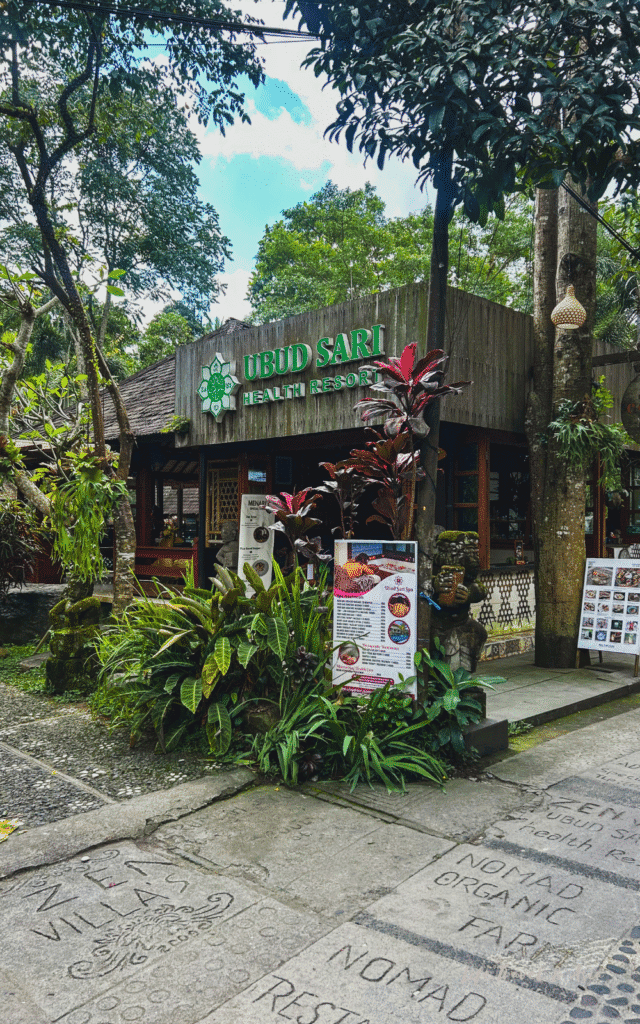
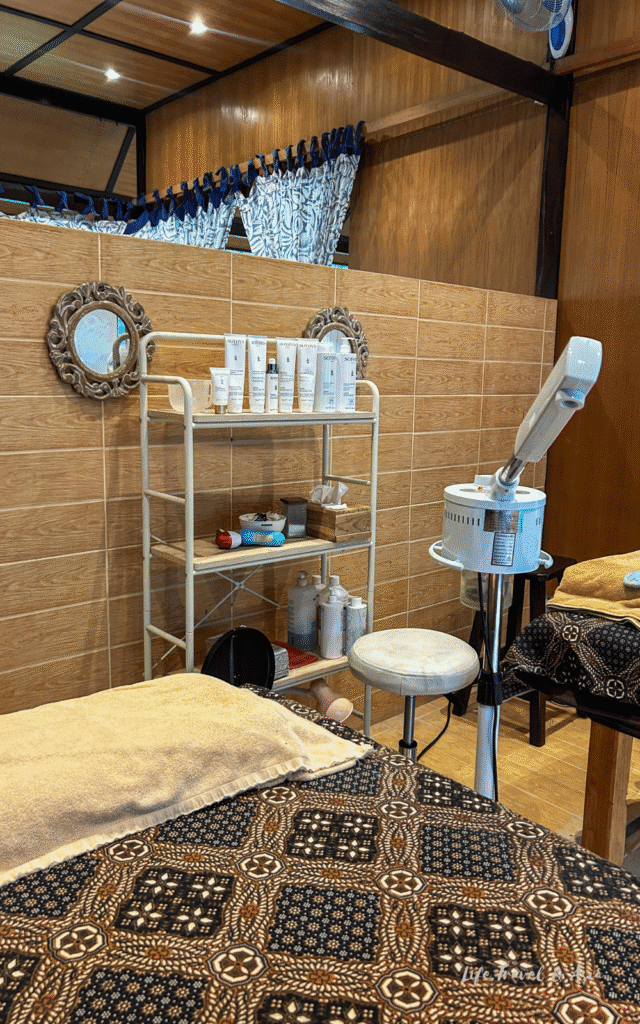
What stood out was the natural setting. It’s a space that invites you to slow down, perfect for a resting moment during a busy trip.
If you’re traveling to Bali and looking for an affordable but high-quality spa experience, this is one of those places that delivers.
Curious about the treatments, prices, setting, and my honest experience? Check out my full Ubud Sari Health Resort review before booking your visit.
21. Join A Yoga Class (Or Any Other Class) at Yoga Barn
You’re not ready for what The Yoga Barn is. It’s not just a yoga studio, it’s a full-on yoga (and well-being) park. The first time I went, I had no idea what to expect. People told me it was huge, but I didn’t imagine a tropical garden with wooden and organic pavilions scattered across the grounds.
The atmosphere is so peaceful that they even hold yoga classes right near the entrance, despite the steady flow of people walking by to reach their class locations. I took a photo of the map just in case I got lost (though I found my pavilion right away).
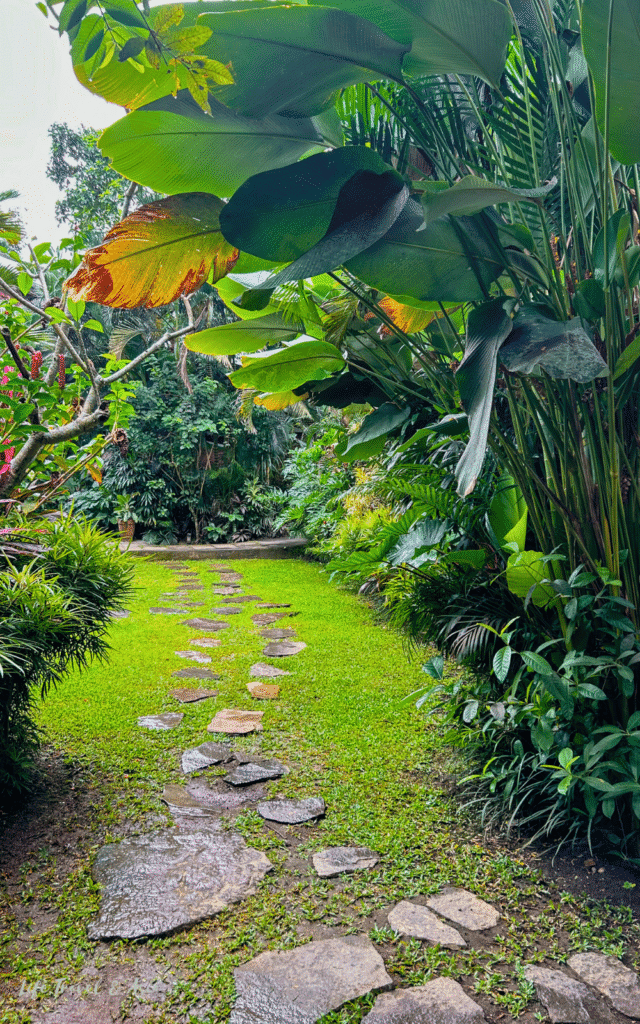
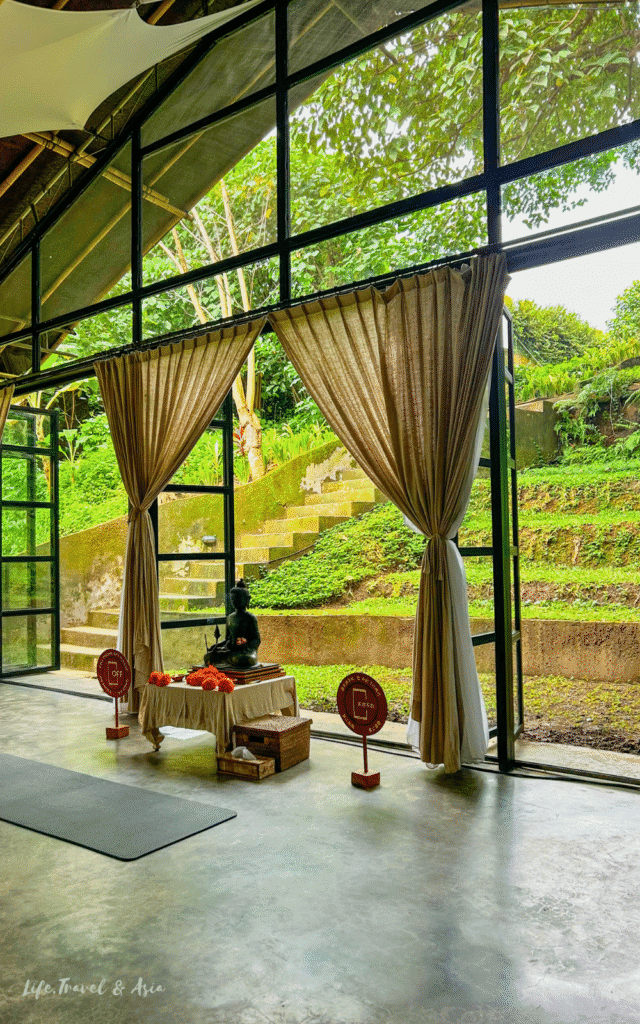
If it’s your first time, don’t worry — the process is super easy. Just check their packed schedule online to find your bonheur, and make sure to arrive at least 45 minutes early to register. Once you get to reception, they’ll tell you where your class is, and you can pay right there. That’s it.
I took a Pilates and a Piyo Class (a mix of Pilates, Yoga, and modern jazzercise) and had the most fun (and the biggest sweat). The instructors were amazing (as expected!) and the class adapted to all levels. I’m definitely planning to go back more than once. This place is a must if you’re into movement, wellness, or simply curious to try something new in Ubud.
If you’re interested in trying other fitness classes, I’ll tell you all about my favorite studios in Ubud. Not only yoga, but also Pilates, dance, and circuit training classes.
22. Book a Pottery Class at Serayu Pot
Craft classes are super popular in Ubud, and pottery is one of the favorites. Serayu Pottery, located on Jl. Gunungsari (just off the main road), is one of the most well-known pottery studios in town.
First of all, the studio is incredibly aesthetic — even before you step inside, you’ll see a charming wall of pottery carvings decorating the entrance.
The studio itself is simple but deeply grounding, and honestly, there’s nothing more relaxing than a pottery class.
They offer both drawing and pottery sessions. For pottery, you can choose between wheel throwing or handbuilding classes. You can check their website for all the details, booking info, and to see just how beautiful the studio is.
23. Experience A Traditional Balinese Cooking Class
Attending a Balinese cooking class is one of the most fun and meaningful ways to connect with the local culture, through one of its most important daily rituals: food.
For Balinese people, cooking is how the day begins, even before placing the Canang Sari offerings. It’s a moment of intention, something often shared with family.
The class I joined was in Bongkasa, a tiny traditional village just outside Ubud, and it was the perfect setting for such an authentic, hands-on experience.


In Ubud, you’ll find plenty of cooking classes advertised in homestays, and I honestly think that’s the best way to do it — by stepping into someone’s home and learning how they cook, prepare spices, and talk about food as something deeply tied to tradition and religion.
Most Balinese cooking classes start with a local market visit, where you’ll explore common ingredients and then head into the kitchen and cook together classic Indonesian dishes.
If you’re curious about my experience, I wrote a dedicated post all about my wholesome cooking class, where I also had my palm read for the very first time. It was one of those unforgettable moments in Bali.
24. Discover The Art of Crafting The Canang Sari
The Canang Sari is the traditional Balinese offering to the Gods, crafted daily to express gratitude and ask for blessings. In Bali — especially in Ubud — you’ll see Canang Sari everywhere: on the roads, in front of shops, on scooters, and sometimes even placed outside your guesthouse door by your host to wish you good luck and protection.
In the mornings, it’s common to see women walking around with leaf baskets full of Canang Sari, gently placing them on altars, near statues, or directly on the ground. To me, it’s one of the most beautiful and ever-present rituals in Bali.

Crafting a Canang Sari is an art, and each element holds meaning. Even the flower colors aren’t chosen randomly — they follow specific religious rules and represent different aspects of the divine.
I learned everything about Canang Sari as part of a cooking class (since the two rituals are closely linked). Still, you can also find beautiful, authentic workshops focused solely on Canang Sari, where you’ll learn all about Balinese gratitude rituals and cultural customs.
If you’re looking for a real connection with Balinese culture, this experience is so much more than just a Canang Sari making class. You’ll be welcomed into the home compound of a Balinese family, where you’ll learn about the religious significance of the Canang Sari and how it shapes the daily rhythm of life in Bali.
25. Attend a Traditional Dance Performance
If you’re in Ubud in the evening, don’t miss the chance to experience a traditional Balinese dance performance — it’s an essential part of the local culture. Shows usually start around 7 PM and are held at beautiful venues like the Ubud Palace, Saraswati Temple, and Pura Dalem Ubud (at the end of Jalan Raya).
You can choose the type of performance based on what you’re curious to see. The Legong Dance is more elegant and delicate, while the Kecak Fire Dance is dramatic and intense, with a large group of men chanting in rhythm around a fire.
No need to book in advance — just walk along the main road around 6 PM and you’ll easily find locals selling tickets on the street.
26. Practice The Melukat Purification Ceremony
The Melukat Purification Ceremony is one of the most meaningful ways to connect with Balinese culture and spirituality.
You don’t need to be Balinese Hindu to participate — it’s a ritual open to anyone, based on the idea of cleansing the body, soul, and spirit from negative energy using holy water. When done with intention, it can be one of the most wholesome and emotional experiences you’ll have in Bali.
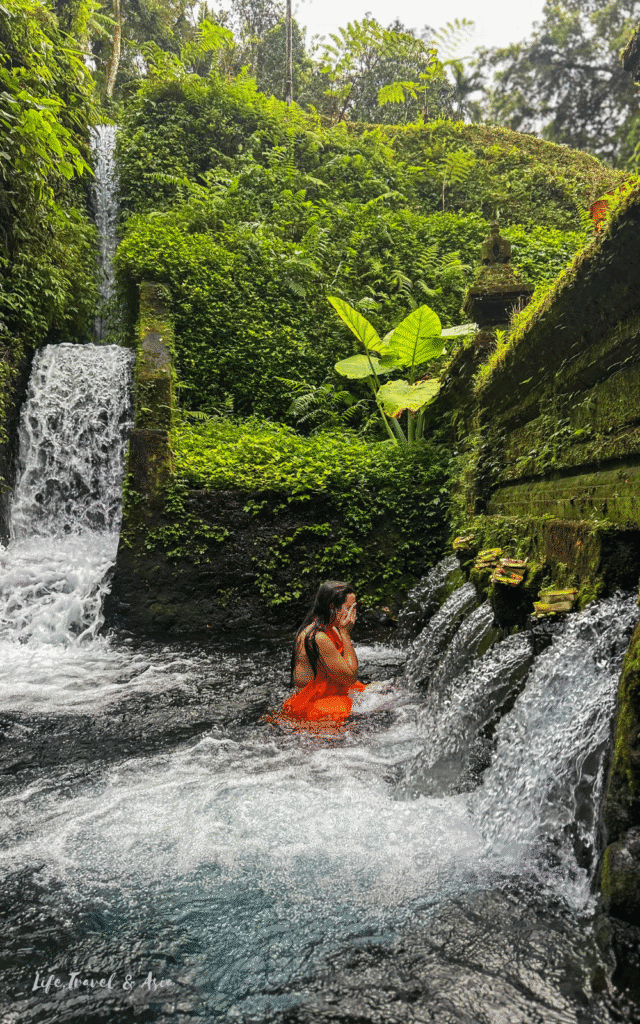
Most visitors head to Tirta Empul, the famous water temple near Ubud, but I found it a bit too chaotic. Instead, I chose to do my ceremony at Pura Mengening, accompanied by a local guide, and it turned out to be one of the most powerful moments of my first week in Ubud.
The temple was peaceful, the ritual felt personal, and the guide made everything incredibly clear and deeply inspiring.
Other beautiful places to experience Melukat include Gunung Kawi Sebatu Temple, as well as some waterfalls and rivers considered sacred by the Balinese.
If you’re curious about my experience, I wrote a post about my Purification Ritual at Pura Mengening. It’s one of those moments from my first week here in Ubud I won’t forget.
27. Try Local Eats At Traditional (And Very Cheap) Warungs
In Ubud — and Bali overall — you can eat incredibly well for just a few dollars. I’m sure you already know that. Local warungs, the traditional family-run eateries, are the best way to enjoy authentic Balinese and Indonesian cuisine without breaking the bank.
In Ubud, you’ll eat well pretty much anywhere. But if you’re looking for some warung and dish recommendations, here you go.
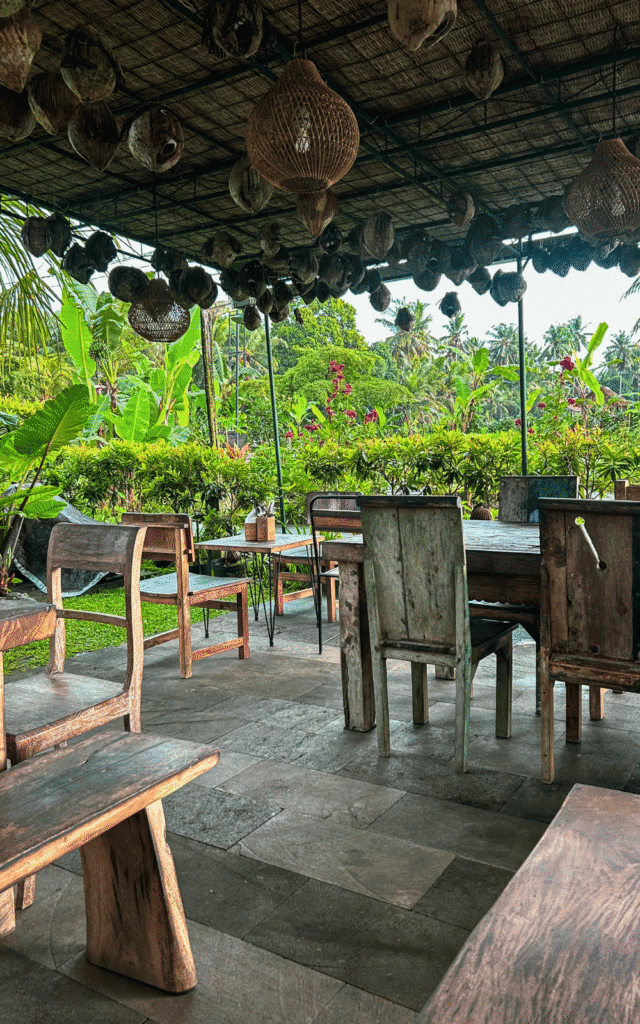
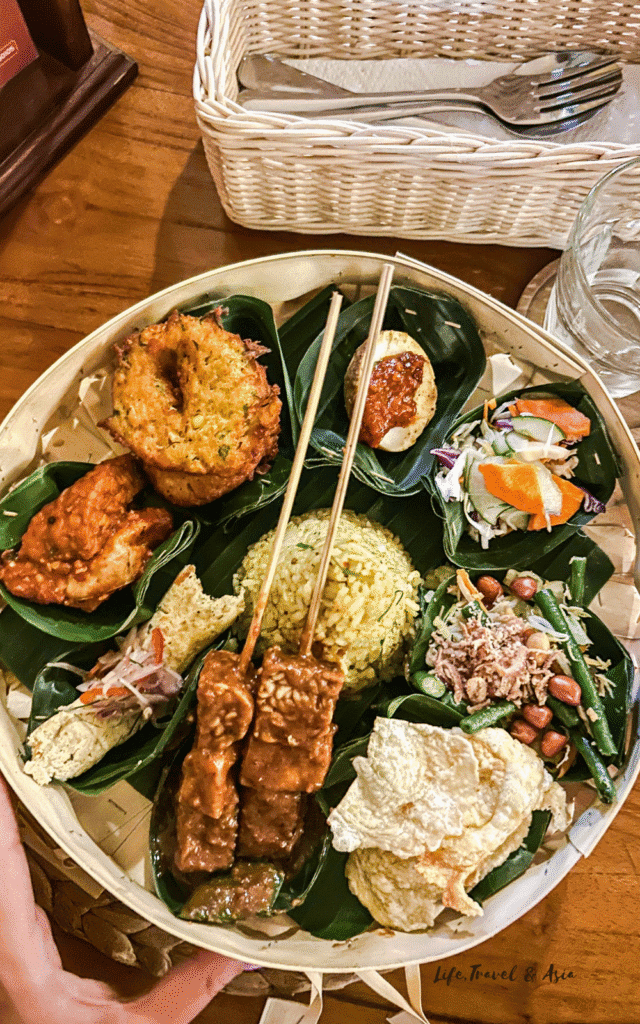
Food aside (because, honestly, it’s good everywhere), Sweet Orange Warung is my go-to on days when I feel like being social and looking for some good vibes. I love having lunch there. Try their vegan tofu and tempeh dish, and don’t miss the sweet potato fries!
If you’re looking for a more modern restaurant vibe but still want traditional flavors at affordable prices, then Nikuna is a great option (arrive early, as it fills up quickly). Try the Nasi Raja here (only 55K in the photo above)
And if you’re looking for the most traditional and authentic flavors and atmosphere, Mama’s Warung is a cozy spot run by a lovely local family — the women are always smiling and so kind. Get the nasi campur here!
Looking for more delicious, vibey, and very cheap Warungs? Here are my absolute top picks!
28. Grab a Breakfast Smoothie Bowl With Rice Terrace Views
My morning walks ending with breakfast overlooking the rice terraces are my favorite moment of the day in Ubud. And if you’re looking for the best cafes with rice terrace views in Ubud, then you need to head to the Sari Organik or Juwuk Manis Walk.
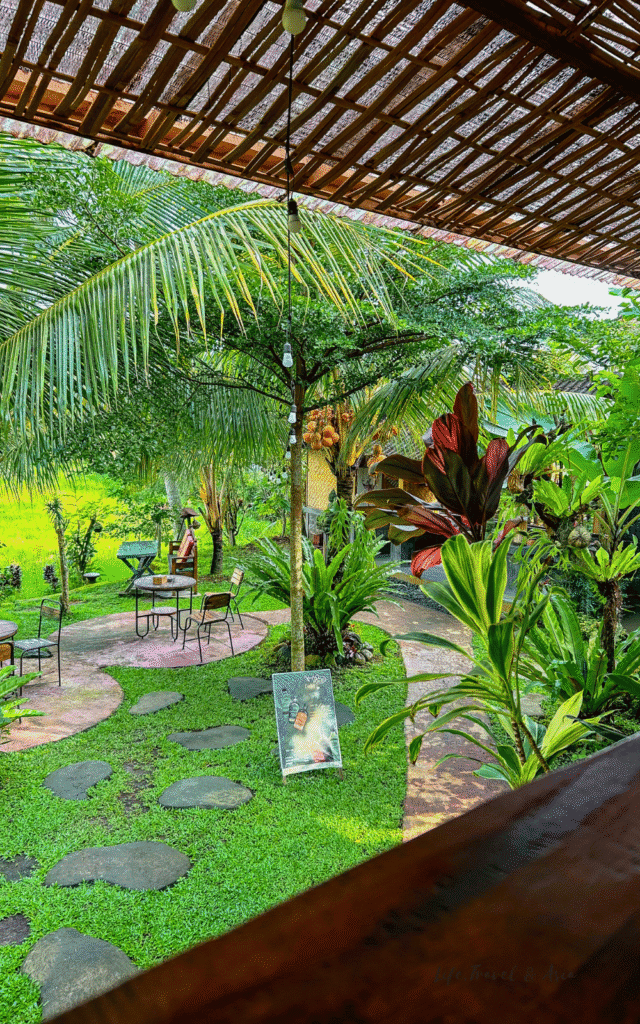
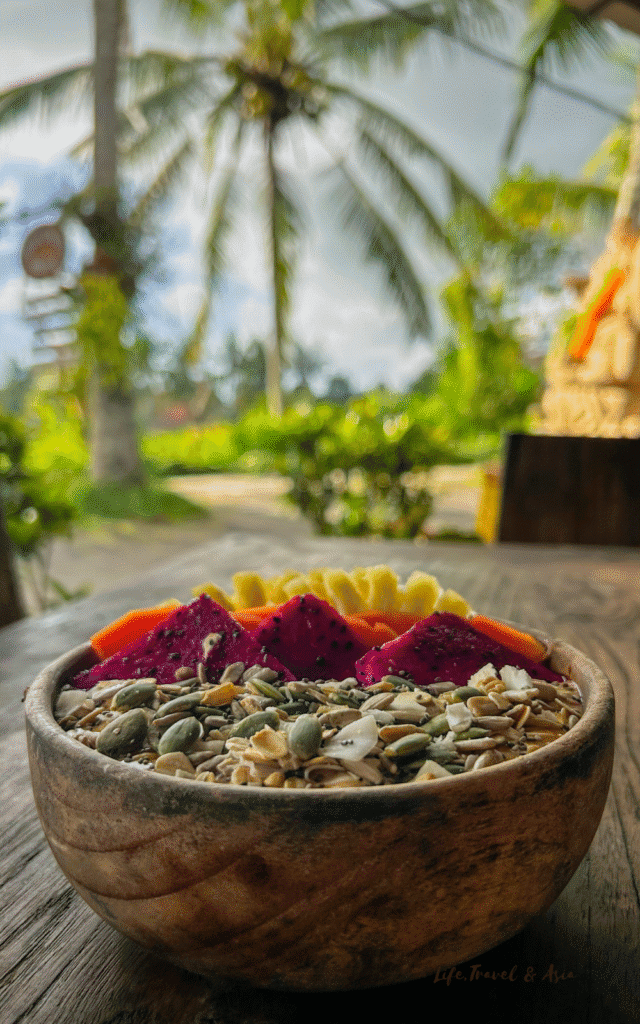
Not only will you get the chance to escape the crowds, noise, and relentless energy of Ubud’s main road, but you’ll also spend a couple of hours with some of the best views in town, surrounded by nature, silence, and a peaceful, authentic atmosphere.
Some of my favorite cafes and warungs with rice field views are Monkey Bar and Joglo Organik on the Sari Walk, and Sweet Orange Warung and Aldi’s Coffee and Eatery on the Juwuk Manis Walk.
29. Try a Full Vegan Meal at Zest
Ubud is a foodie’s heaven. Honestly, I don’t think I’ve had a bad meal since moving here. But if there’s one place I always recommend to anyone visiting Ubud, it’s Zest—whether you’re vegan or not.
Located in Penestanan, surrounded by jungle and towering trees, Zest sits up on a hill and feels like you’re eating in a treehouse. The vibe is hippie, spiritual, and totally in sync with its crowd: creatives, digital nomads, writers, musicians, and of course, curious travelers passing through.

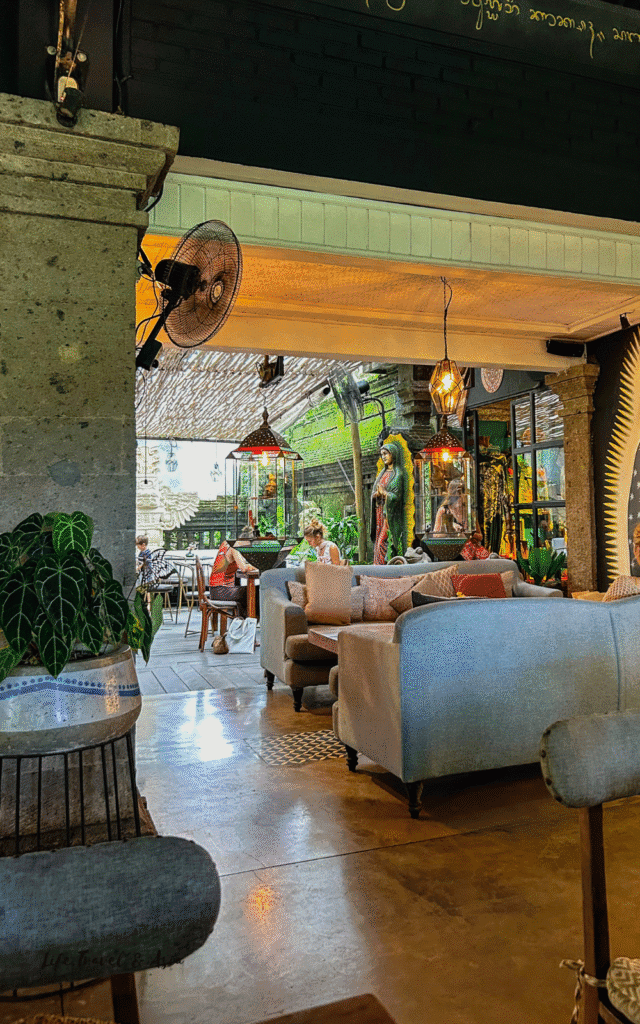
The menu is 100% vegan and a little on the pricier side (by Bali standards), but honestly? I’d happily sign up for this lifestyle if all vegan food tasted this good. From fully plant-based pizzas and healthy bowls to noodles and unique desserts, everything is so good—and you don’t even realize it’s vegan because it’s just delicious.
Definitely go at least once while you’re in Ubud. You won’t regret it.
30. Dine at A Rooftop Overlooking the Jungle
Between all those delicious Warung lunches and dinners, you might find yourself craving something a little fancier while in Ubud.
During my first trip, my friends and I tried Cantina Rooftop and ended up having a full-on 11-course tasting menu that we could barely finish. Every single dish was amazing — from vegetable gnocchi and couscous to juicy pork and homemade ice cream.
It’s not your typical Indonesian meal, but Cantina Rooftop is worth checking out. It’s located just before the Penestanan area (right before Zest), overlooking the river valley, the Campuhan Ridge Walk, and one of my favorite temples in Ubud — Pura Gunung Lebah.
The vibe is super chic yet cozy, kind of like a stylish lounge restaurant a well-stocked bar and tasty cocktails. I highly recommend going before sunset so you can enjoy the view from up there while the sun sets over the valley and temple below.
31. Go River Rafting in The Ayung River
Rafting on the Ayung River is one of my most exhilarating experiences in Ubud. The adventure takes you on a ten-kilometer journey over about two hours, led by some of the funniest Indonesian guides.
I booked my rafting trip HERE, with the Balinese company Graha Adventure. They handled everything—providing all the equipment, arranging transportation to and from the river, and always having their staff guiding. Lunch is included in the ticket price.
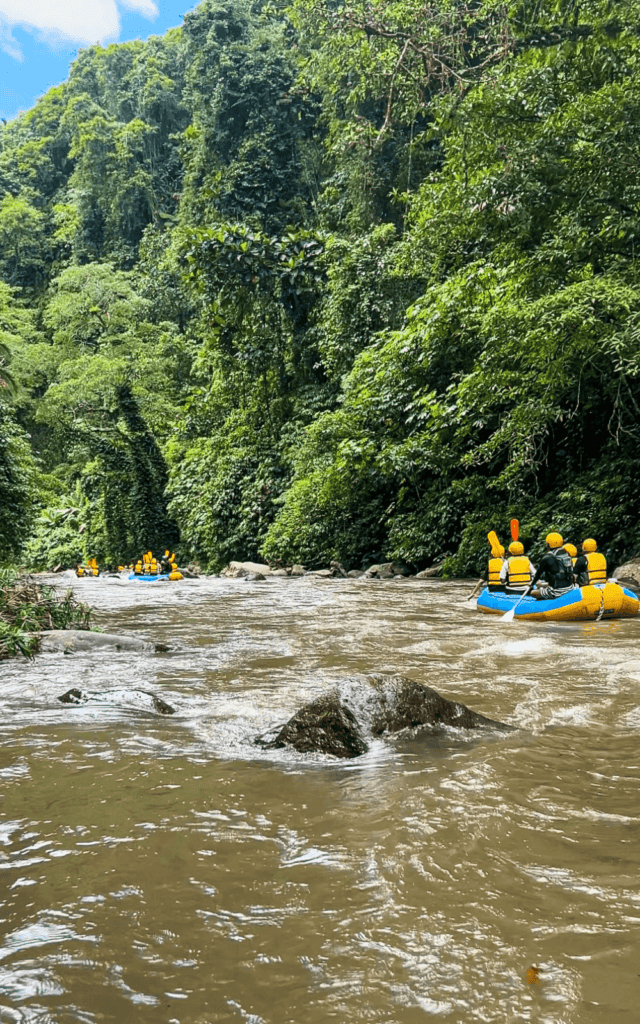

The rafting is pretty easy but offers enough challenges for beginners. You might find yourself stuck between rocks a few times, trying everything to get free, or after a series of rapids, you might tumble from your spot on the raft.
The guides are there to lead you throughout the trip, making the experience even better with their random shouting commands that sometimes seem counterintuitive. Along the way, you can stop at a waterfall and at a drink stall to enjoy a coconut.
If you want to plan your rafting experience or are just curious to know if it’s something for you, here’s everything you can expect from a rafting experience in Ubud: from the organization, to what to pack, and the best tour to book.
32. Plan a Waterfall Hopping Day
Ubud is busy and touristy, but it only takes a few minutes to escape into peaceful village roads, surrounded by jungle, fruit stalls, and sleepy dogs lying in the middle of the street like they own it.
And of course, there are waterfalls everywhere. From just 15 minutes away to an hour’s drive east, north, west, or south, the only real challenge is choosing where to go.
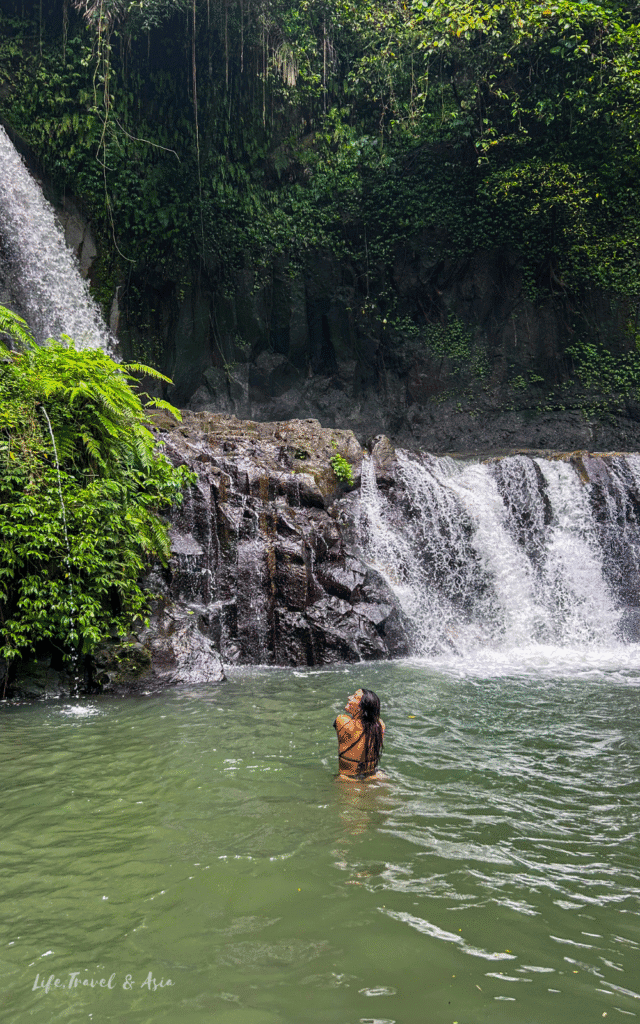
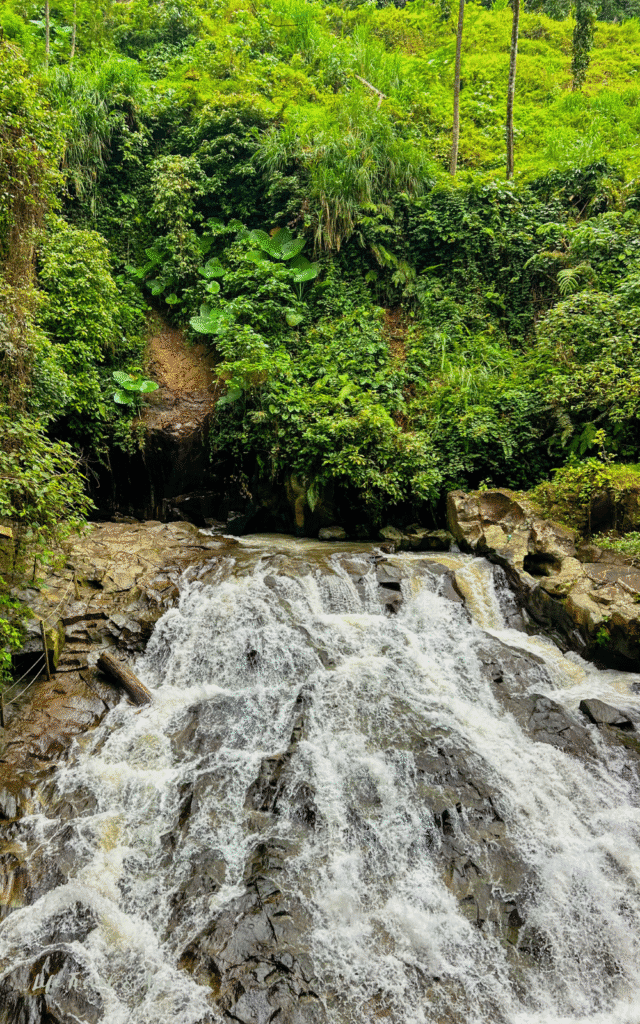
Some of the most well-known (and most visited) are Tegenungan and Kanto Lampo. But if you’re looking for something quieter, there are also plenty of smaller, hidden waterfalls deep in the jungle, where it’s just you. And those are the ones truly worth exploring.
During my first (and not last) waterfall hopping day around Ubud, I visited Suwat, Tibumana, Taman Sari, and Goa Rang Reng — and honestly, it was so peaceful and worth it. I only crossed paths with seven other people in total across all four waterfalls.
If you want to plan your waterfall tour around Ubud or are looking for the best-organized options, here’s how I put together my own half-day waterfall hopping trip with my fantastic driver, Putu, and how you can easily plan yours too.
I told you! Ubud is full of amazing things to do—and unfortunately, you probably won’t have time to see it all (unless you’re moving here… in that case, let’s meet!).
These are the absolute best things to do in Ubud, but if you’re short on time, I’ve also put together two one-day itineraries that you can mix and match. They include a perfect combo of must-see spots and hidden gems—super helpful if you want to make the most out of just a couple of days.
And if you’re still planning your trip, my Ubud Travel Guide covers everything else you might need to know. Any questions? Drop it in the comments! One of my biggest missions is to help you experience this magical town in the best way possible ✨


